Thinking about adding a small, sociable pet to your family? Consider cavies — aka guinea pigs — as a fun, gentle pet that the whole family can enjoy. Learn everything you need to know about them in guinea pig care 101. From their care to understanding their behaviours, here’s the scoop on keeping guinea pigs healthy and happy and how to create cavy companionship that will last a lifetime.
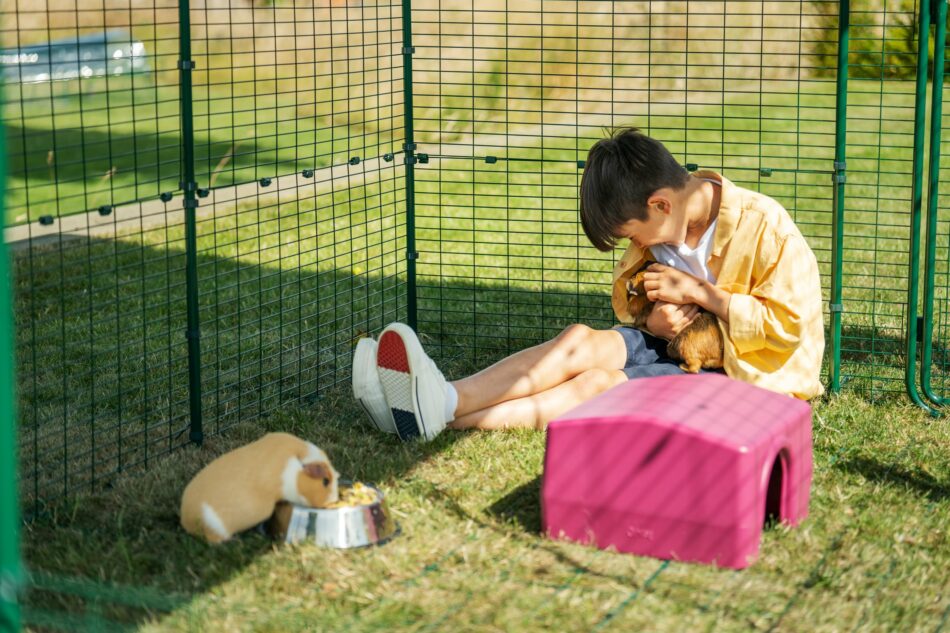
What to expect with guinea pigs
Guinea pigs are known for their sweet temperaments and social nature, and come in a variety of cavy coat textures and colours. But like all pets, guinea pigs have their own unique personalities. From diet and housing to health and hygiene, understanding their core needs will set the foundation for a rewarding bond.
Guinea pigs as pets
There’s no doubt about it: cavies are captivating. From their unique vocalisations to their adorable appearance, guinea pigs can bring years of enjoyment to families. Guinea pigs are members of the rodent family, and are active, personable, and entertaining to have as companions. They thrive in pairs or small groups — a single guinea pig should never be kept alone. Children can care for cavies with the help of adults, and most guinea pigs are receptive to being gently handled.
Cavies communicate through a range of sounds. This guinea pig language can range from excited squeaks — or “wheeks” — to low rumbles and soft chattering. They’ll quickly learn to associate you with food and attention, and most guinea pigs will welcome their owners with a series of sounds from their repertoire.
They’re best for people who can spend time each day offering gentle interaction and basic care. While they may be more sturdy than other rodents, they require a steady hand and calm environment to feel safe.
Diet
A healthy guinea pig diet is centered around one key element: hay — and lots of it. Unlimited fresh hay is essential for their digestion and for keeping their ever-growing teeth in check.
A balanced guinea pig diet includes:
- Unlimited fresh grass
- Unlimited hay (timothy hay for adults; alfalfa for younger cavies).
- Daily vegetables and leafy greens like romaine, bell peppers, carrot tops, or cucumber.
- Pellets fortified with Vitamin C (guinea pigs cannot produce their own)
- Fresh water, refreshed daily.
Fruits can be offered only as occasional treats, and sugary or starchy foods should be avoided. Be cautious with iceberg lettuce, which offers little nutritional value, and vegetables high in oxalates like spinach or parsley in large quantities.
Housing
Cavies need more space than many people realise. They are active animals that enjoy running, hiding, and socialising with their enclosure mates. Cramped, traditional guinea pig cages lead to boredom and health issues like obesity or illness.
Ideal guinea pig housing includes:
Most guinea pigs do remarkably well when housed outdoors. However, certain breeds like Skinny Pigs should be housed indoors since they don’t have hair to help regulate their body temperature. Peruvians are another guinea pig breed that should be monitored closely outdoors due to their long coats.
You’ll need to spot clean your guinea pigs’ hutch daily to keep it fresh — and thoroughly clean their hutch weekly by replacing the bedding, wiping or spraying the smooth surfaces clean, and cleaning their bowls and toys. Choose a soft, absorbent bedding to keep dust and odours down, and to support good sleep.
Social needs
Unlike their rodent cousin the hamster, guinea pigs should never be housed alone. Cavies are highly social and should always be kept in pairs or small groups. A bonded pair of the same sex or a neutered male with a female are the most successful pairings. Their interactions provide comfort, stimulation, and emotional security.
While they enjoy human interaction, guinea pigs can be shy at first. Gentle, consistent handling helps build trust. Talk to them softly, move slovenly, and offer food by hand to reinforce positive experiences.
Health care
Guinea pigs are relatively hardy, but they do have some unique health considerations. Regular observation is key — many illnesses can be subtle until they become serious.
Here are some signs that point to illness in guinea pigs:
- Changes in eating or drinking habits
- Weight loss or lethargy
- Discharge from the eyes or nose
- Limping, bloating, or laboured breathing
- Overgrown teeth or drooling (indicative of dental issues)
Routine vet visits with a cavy-savvy veterinarian are helpful in keeping your guinea pigs healthy and happy. Nail trimming, grooming (for long-haired breeds), and checking for external parasites like lice or fleas should be part of your care routine.
It’s also important to be sure that your guinea pigs are getting enough Vitamin C, as deficiencies can lead to scurvy — a common, but preventable issue. Most commercially bought guinea pig feed is fortified with Vitamin C, but check the ingredients to be sure, and work with your veterinarian to see if your cavies need additional supplementation.
Other considerations
While not necessarily a necessity, accessories can elevate your guinea pigs’ — and your — experience. Consider adding these fun and engaging elements to your cavies’ setup:
These accessories have been designed to foster natural behaviours of guinea pigs, and provide endless opportunities for exercise and excitement.
Omlet and your rabbits
At Omlet, we believe your guinea pigs’ habitat should be just as smart and thoughtfully designed as your own home. Our Eglu Go Guinea Pig Hutch provides a safe, easy-to-clean, and weatherproof space for outdoor cavies. Round out your setup with Zippi Guinea Pig Runs and Playpens and Zippi Guinea Pig Tunnels to provide essential enrichment that all speak to their nature. Our products — combined with your love — make it possible to care for your guinea pigs in a simple, sustainable, and supportive way for years of cavy companionship.
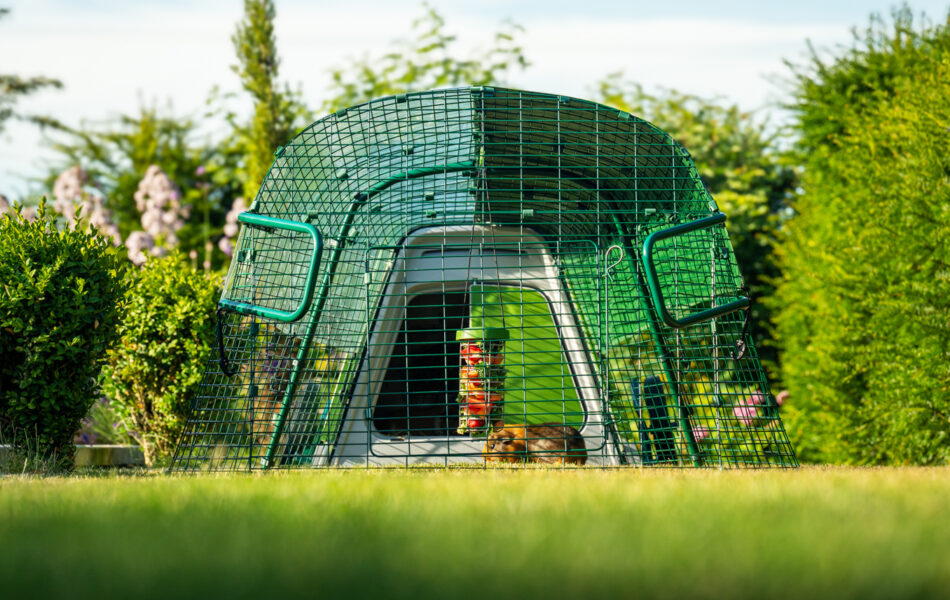

This entry was posted in Guinea Pigs
Looking for some setup ideas for your small pet? With the beautiful weather and fresh air, your rabbits and guinea pigs are kicking their outdoor activities into high gear. Here’s how to maximise their space, offer plenty of enrichment, and keep them safe in their outdoor setup.
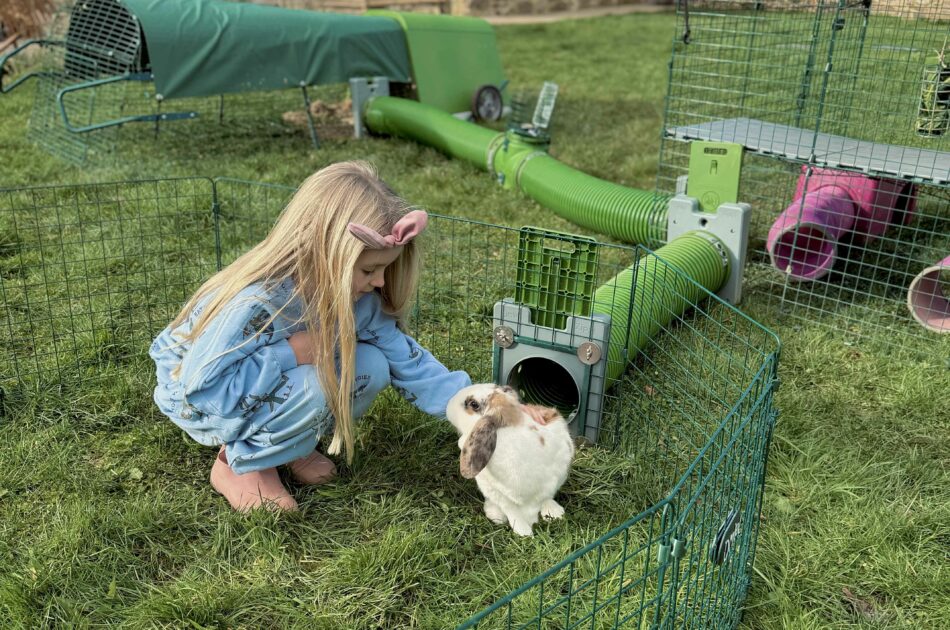
Small pet outdoor setups
Your rabbits’ or guinea pigs’ outdoor setup is more than just a space to play — it should offer them ample protection from the elements and predators. So before designing their inner sanctum, you’ll want to be sure that their enclosure is as safe as possible. To start your rabbit or guinea pig setup, make sure you have:
Once you’ve invested in these essentials, it’s time to create the perfect environment within.
Appeal to their nature
One of the best ways to ensure your rabbits’ and guinea pigs’ happiness is to appeal to their natural instincts and behaviors. For these small pets, activities like foraging and burrowing top the list. Thankfully, there are several ways to incorporate these activities in their outdoor space.
In the wild, rabbits excavate extensive tunnel systems. These tunnels provide shade and shelter while allowing them to exercise and explore. And while they may not dig their own, wild guinea pigs seek the shelter and safety of burrows created by other animals. This activity is a favorite of most rabbits and guinea pigs, and should be fostered whenever possible. Here are some ideas to create rabbit and guinea pig-friendly burrows in their setup:
- Create an above-ground burrow with a Zippi Rabbit and Guinea Pig Tunnel System that can be connected to any hutch or run.
- Cover a large-diameter PVC pipe with sod or top soil to create an earthy tunnel.
- Offer plenty of rabbit shelters or guinea pig hides throughout their enclosure.
- Partially bury large terracotta pots laid on their sides to create a cave-like shelter.
- Create a “dig box” for rabbits using a plastic container large enough for them to hop into, filled with hay, shredded paper, untreated sand, or other rabbit-safe substrates.
Foraging is also important for both species. Use a hanging rabbit and guinea pig treat holder to simulate this activity in their enclosure. Offer leafy greens, herbs, and other bunny and cavy-safe treats at a level that encourages them to stretch and scrounge for diverse vegetation.
Create more space
Like most pets, rabbits and guinea pigs thrive when they’re provided as much space as possible. This can be accomplished several ways, and it’s as beneficial for you as it is for your small pets:
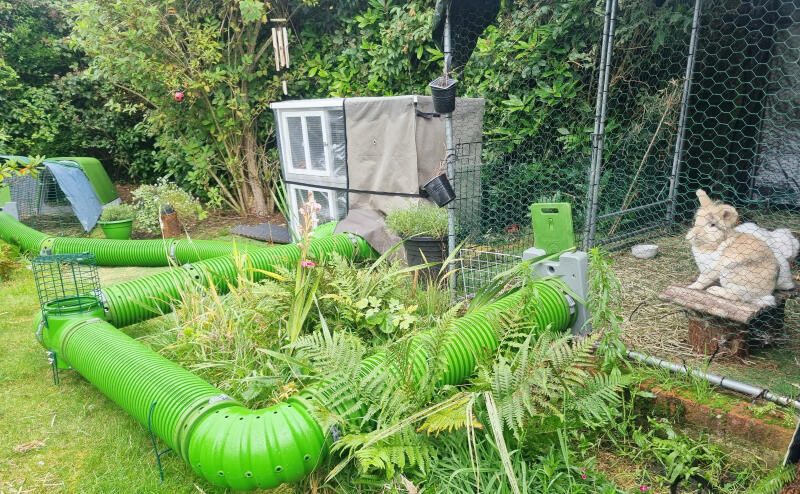
By connecting multiple runs and playpens together, you can change your pets’ experience between each of their areas. For example, one area can be dedicated to feeding, while another could hold enrichment items like toys, dig boxes, and treat holders. This further simulates the feel of a burrowing system that your pets would be utilising in their natural habitat.
DIY and complementing elements
DIY options for your rabbits’ and guinea pigs’ enclosure can be a fun project, and many are inexpensive. Some ideas include:
- Cardboard box mazes
- Paper towel or toilet paper tubes stuffed with Timothy hay
- Edible garland made from fresh veggies
And, with rabbit and guinea pig droppings being prime fertilizer for gardens, planting a garden near your rabbits’ or guinea pigs’ setup gives your plants quick access to nutritional excellence. You can also plant rabbit and guinea pig-safe plants and herbs in planters along the edges of your small pets’ run for them to nibble through the openings in the wire.
What to avoid in your small pets’ setup
Along with items safe for your bunnies’ and cavies’ setup, there are also elements to avoid. These include:
- Towels or other cloth materials that a toenail could easily snag on
- Plush toys (unless during supervised play)
- Electrical cords within reach of your pets
- Treated lumber
- Cedar wood or shavings
- Objects small enough for your rabbits or guinea pigs to choke on
This isn’t an exhaustive list, so if you’re unsure about what may or may not be safe for your pet, conduct thorough research through reputable sources. Breeders, national associations, rescues, and veterinary offices are all excellent resources to help you make safe choices for your small pet’s setup.
Omlet and your small pets
At Omlet, we believe that pet ownership should be about mutual fun, love, and companionship. That’s why we created safe rabbit and guinea pig hutches that are easy to clean and will keep your pets comfortable all year round. Combined with our line of Zippi Rabbit and Guinea Pig playpens, Zippi Rabbit and Guinea Pig Tunnel System, and Zippi Rabbit and Guinea Pig Platforms, your bunnies and cavies will have a small pet setup that will entertain and support them in every season.
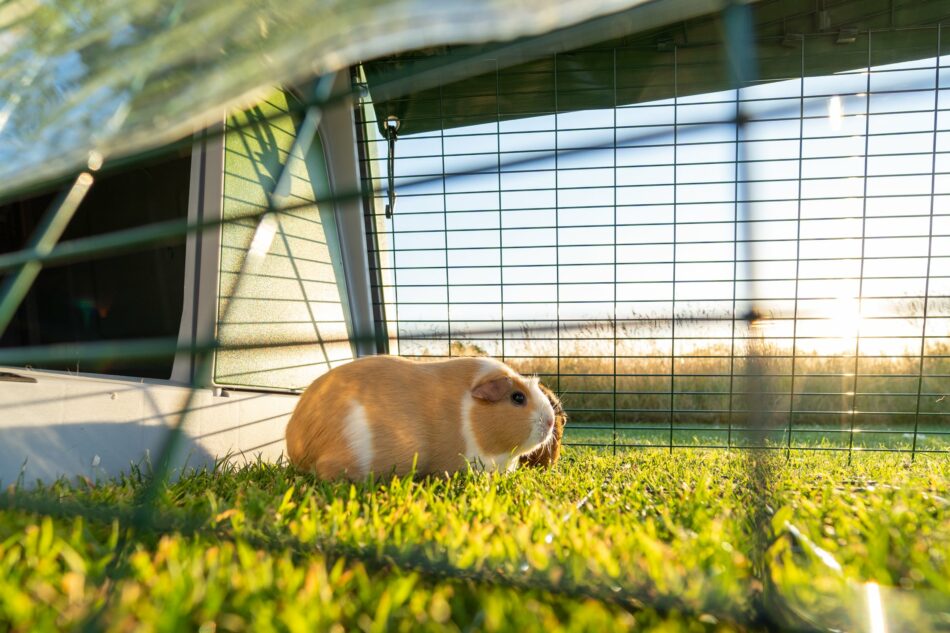

This entry was posted in Guinea Pigs
The upcoming season is one of the best for small pets, and creating your spring checklist for rabbits and guinea pigs is part of the fun. With sunshine, grass, and vegetation returning, it’s the perfect time to spruce up your pets’ outdoor space, or to set up their home as a first time bunny or cavy owner. Here’s everything you need to make sure your rabbits and guinea pigs are all set for spring and beyond.
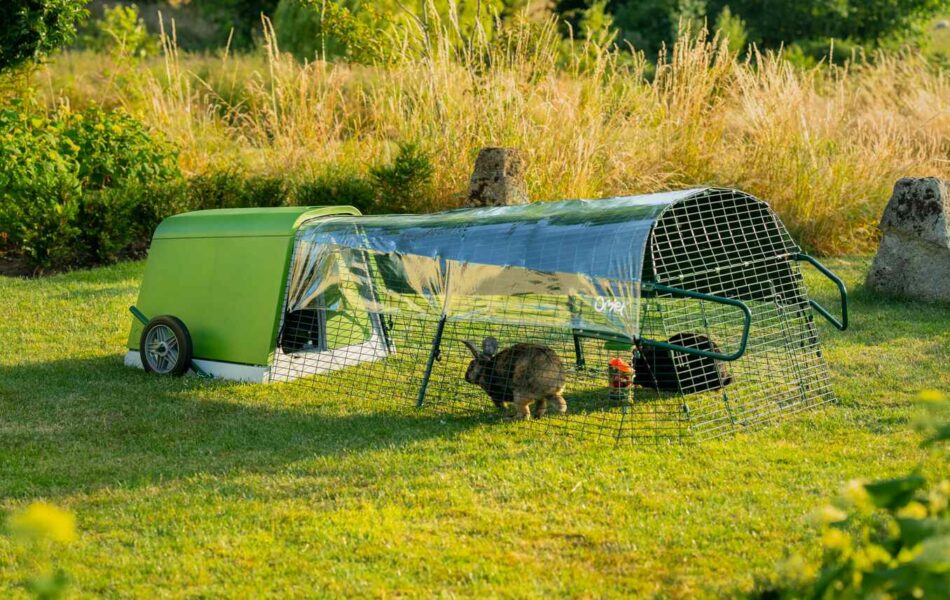
Outdoor rabbit and guinea pig setups
Your pets’ outdoor setup should be safe, secure, and supportive. Rabbits and guinea pigs are prey animals, and they need to feel protected in their environment in order to fully enjoy their experience outside. To create a safe rabbit or guinea pig setup, you’ll need:
With all of these elements in place, you’ll be able to create a safe and supportive space that will enable your rabbits and guinea pigs to enjoy spring outside in their natural environment.
An outdoor hutch
Rabbits and guinea pigs need a safe outside space to retreat to in the event of adverse weather, and to keep them safe from predators. Their hutch serves as their house, and should be both comfortable and protective. This is especially true if you intend to house your bunnies or cavies outside full-time.
An easy to clean, insulated rabbit and guinea pig hutch is the best choice for keeping your small pet safe and supported while they’re outside. The Eglu Go Rabbit and Guinea Pig Hutch is safe and strong, and only takes a couple of minutes to clean thoroughly, protecting your pets against predators, the elements, and unsanitary living conditions.
Plastic rabbit and guinea pig hutches also have the advantage of not becoming chew toys for your pets. Rabbits and guinea pigs love to chew on wooden surfaces, and most traditional hutches are chewed to the point of compromising their structural integrity. With strong plastic hutches, you’ll never have to worry about your pets gnawing their way into a hazardous scenario.
Room to run
Your rabbits’ and guinea pigs’ run is another vital component of their outdoor setup. Rabbit runs should have strong mesh to act as flooring to prevent tunneling out, while guinea pigs need to have constant contact with the ground to promote good foot health.
Guinea pig and rabbit runs can easily be connected to an Eglu Go Rabbit and Guinea Pig hutch, and can be lengthened with expansion kits to give them more room to run. The attached runs are fully enclosed with heavy-duty weld mesh to protect against predators of all shapes and sizes.
If you have a traditional wooden hutch, or want to provide even more space, Zippi Rabbit and Guinea Pig Runs and Playpens can be set up anywhere you need them. Or, for the ultimate outdoor space, a Walk In Rabbit and Guinea Pig Run allows you convenient and comfortable access to play with your pets.
Protection from the elements
Weather covers keep your cavies and bunnies dry, shaded, and protected from the wind. They can be securely attached to your pets’ runs in just seconds, and are made from heavy-duty material designed to last a lifetime. The solid covers are perfect for blocking UV rays, while the clear covers allow warming sunshine to permeate the run during the cooler days of early spring.
Additional elements
While not a must-have item, one of the single most fun activities to enjoy with your rabbits and guinea pigs is to watch them race through Zippi Rabbit and Guinea Pig Tunnels. Create a course custom to your space and your pets’ skill level, and grow it as often as you’d like. The quick-connectors allow you to arrange and rearrange their above-ground burrow with ease, allowing you to change up the configuration for more of a challenge. Both bunnies and cavies enjoy burrows as part of their nature, and Zippi Tunnels appeal to this instinct handed down by their wild ancestors.
Guinea Pig and Rabbit Ramps and Platforms are another non-essential, but excellent addition to your small pets’ outdoor setup. The platforms give your pets shade and seclusion below, and a new vantage point above. And, the elevated surface is perfect for interacting with you on a whole new level. The ramp helps strengthen leg muscles — especially for guinea pigs — and makes use of vertical space in their run.
Rabbit shelters guinea pig shelters are also helpful in providing additional privacy and security while your pets are out and about in their runs. And, Caddi Rabbit and Guinea Pig Treat Holders can be added to your pet’s run to encourage foraging behaviors for healthy and nutritious snacks. Both of these accessories encourage and foster natural behaviors to help your pets get in touch with nature.
Omlet and your small pets
Check off your outdoor rabbit and guinea pig essentials list with Omlet, and ensure they have safe, supportive setups this spring, and for every season after. With an exceptionally safe rabbit and guinea pig hutch, a spacious outdoor rabbit and guinea pig run, and exciting elements like above-ground burrows, you and your pets can have the best spring ever — at least until next year, when you can enjoy it all over again.
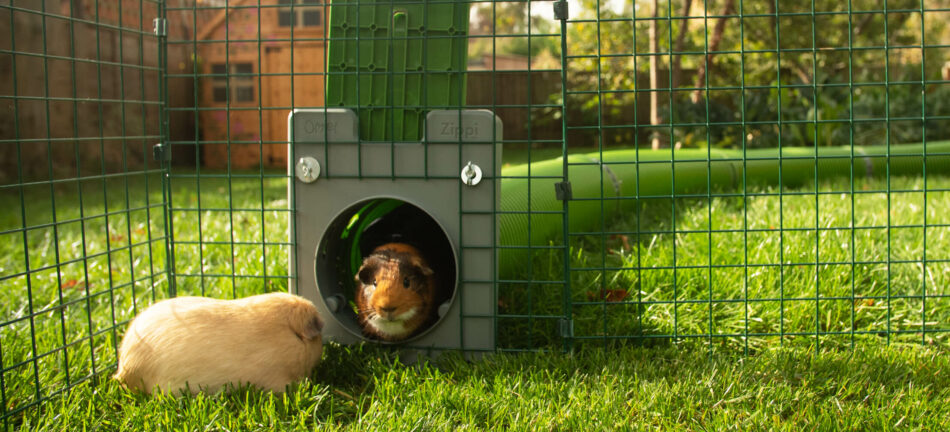

This entry was posted in Guinea Pigs
Understanding rabbit and guinea pig behaviour sets the foundation for a lifelong relationship with your pets. And when you take cues from your bunnies and cavies, you’ll know how to help them live long, healthy, and fulfilled lives. Here’s everything you need to successfully keep rabbits and guinea pigs, and how these elements help foster their natural behaviours.

Rabbit and guinea pig basics
Keeping rabbits and guinea pigs should be enjoyable, so choosing products that speak to their natural behaviours while being easy on your workload are a win-win. Here’s everything you need to foster a relationship with either rabbits or guinea pigs.
A safe hutch and run
As prey animals, rabbits and guinea pigs need to feel safe in their home. Both species need quiet, insulated, enclosed hutches to get a reprieve from the stimulating outside world and to keep them safe from predators and the elements. Providing a safe Rabbit and Guinea Pig Hutch is vital for their happiness and health. But what constitutes safety? A safe rabbit and guinea pig hutch will effectively protect your pets from all threats, from the weather to predators like hawks and raccoons. This refuge will be where your rabbits go to retire for the day, and what your guinea pigs will gravitate toward.
Quality food and fresh water
Both bunnies and cavies have teeth that continuously grow, and their diet helps them keep them in check. Quality pellets made from Timothy hay, and fresh Timothy hay offered free-choice will help keep their teeth filed down, as well as help their digestive tract move smoothly.
Guinea pigs also need vitamin C fortified feed, as they cannot manufacture their own. Bunny and cavy-safe treats like lettuce or other fresh fruits and vegetables can be offered in a Caddi Rabbit and Guinea Pig Treat Holder to supplement their diet in a nutritious and engaging way.
Bedding
Soft bedding should be provided to rabbits and guinea pigs to rest and nest in. Think of your bun or cavy’s bedding as a mattress topper and duvet for you — something soft to sink into at the end of the day. In the warmer months, pine shavings or pellets are a nice choice, as they don’t trap much heat. During the winter, opt for a thick layer of straw to help bolster their hutch insulation. Recycled paper pulp bedding also offers comfort year-round. Bedding also absorbs moisture and odours, helping to keep your pets’ hutch and their coats clean and fresh.
Bonus elements
With the essentials on hand, you’ll provide your rabbits and guinea pigs with what they need in order to be healthy and happy in their home. But there are some additional elements to add to elevate ordinary life to an extraordinary level. These accessories might not be essential to the health of your bunnies and cavies, but they will do wonders for their minds and bodies — and for your own enjoyment.
Above-ground burrows
In the wild, rabbits build extensive tunnels, known as burrows, to form a large network called a warren. Multiple rabbits share a warren, and use the connected burrows to relay messages, access the above-ground world, as well as for sleeping, eating, and shelter during times of danger or weather events. And while they may not dig their own, wild guinea pigs will find abandoned burrows or dens dug by other animals for the same purposes.
Investing in some Zippi Rabbit and Guinea Pig Tunnels simulates this type of burrowing network, and makes it easy for you to create new routes and pathways to explore. Having these above-ground burrows channels their natural instinct and provides a sense of safety and shelter, whilst making their home more exciting.
Platforms for prime viewing
Being animals of prey, rabbits and guinea pigs often seek a higher vantage point to get a better view of the world around them. Rabbit and Guinea Pig Platforms give your pets this space to get a glimpse of their surroundings, while also offering a shaded space below. The ramp exercises their leg and back muscles, and the elevated surface helps you interact with your pets on a whole new level.
Spacious playpens for epic play sessions
Rabbit and Guinea Pig Playpens are the perfect space to hangout with your pets, or for conducting training sessions, grooming, or playtime. Connect multiple playpens together to create the ultimate warren, or opt for a fully-enclosed Walk In Rabbit and Guinea Pig Run for all-around safety and comfort. The more space you can provide your bunnies and guinea pigs with, the better it is for their minds and bodies.
Other considerations
While these might not be tangible goods, there are some other angles to consider when keeping rabbits or guinea pigs. These provisions will ensure that your bunnies or cavies are being supported in aspects beyond their housing and enrichment. They include:
- Veterinary care for if your rabbit or guinea pig experiences illness or injury. Be sure to research veterinarians that treat rabbits and guinea pigs specifically, as they aren’t part of every small animal veterinarian’s realm of expertise. A veterinarian can also spay or neuter your rabbits or guinea pigs if needed.
- Choose a pet sitter for when you need to go out of town. Bunnies and cavies should be fed daily, so someone will need to care for them while you’re away. Keep an updated list of care instructions to provide, and invite your designated pet sitter over to introduce them to your pets ahead of time.
- Set expectations for you and your pets. Part of understanding rabbit and guinea pig behaviour is observing them and recognizing when they’re being pushed out of the comfort zone. Always make sure to interact in a place and at a pace that your pets are comfortable with, being sure to make each interaction as positive as possible.
With these things in mind, along with a supportive setup, your bunnies and cavies will be equipped to share a lifetime of experiences with you.
Omlet and your rabbits and guinea pigs
All over the world, pet parents of rabbits and guinea pigs choose Omlet to house and provide for their furry family members. From ultra-strong and supportive Rabbit and Guinea Pig Hutches and secure Rabbit and Guinea Pig Playpens, to unique Zippi Rabbit and Guinea Pig Tunnels and Rabbit and Guinea Pig Platforms, you’ll appeal to your bunnies’ and cavies’ natural behaviours and foster the bond forged between pet and owner with our ingenious pet products.
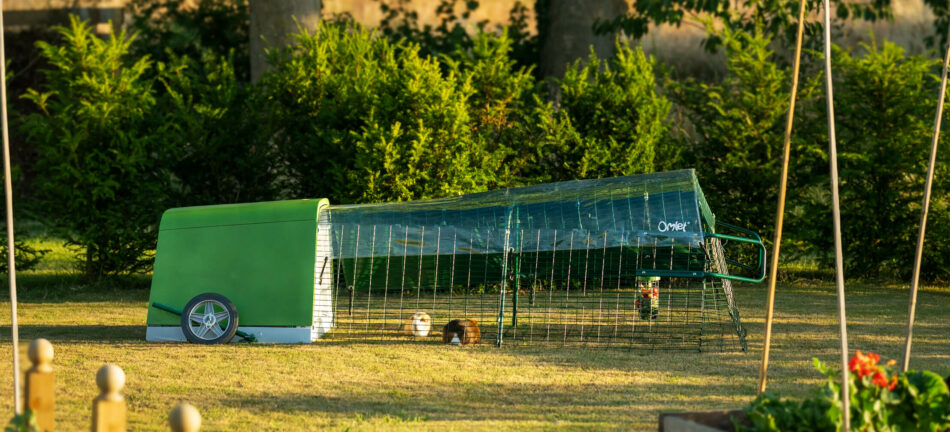

This entry was posted in Guinea Pigs
It’s officially autumn — the air is crisp, the leaves are changing, and the temperatures are dropping. But these changes don’t go unnoticed by your four-legged family members. Find out how to help your rabbits and guinea pigs cope with the changing seasons, and learn what to expect from your pets as they make the transition into the colder, wetter weather.

Combating the cold
For many rabbit and guinea pig owners, cold weather is a reality that autumn brings. The best way to help your pets cope with the cooler temperatures is to ensure they have an insulated rabbit and guinea pig hutch. This will give them a reprieve from the bite in the air, and allows them to acclimate to the outdoor temperatures on their own terms.
While most bunnies and cavies that are accustomed to spending time outdoors will thrive in the crisp temperatures, it’s important to keep a close eye on them. Watch for signs of hypothermia in rabbits and guinea pigs, which include:
- Shivering
- Lethargy
- Pale feet or mucous membranes
As the temperatures approach freezing, it’s especially important to keep an eye on your guinea pigs. While they can thrive outdoors throughout the majority of the year, if you live in an area that experiences extreme temperatures, it’s time to bring your guinea pigs indoors for the season. Skinny pigs are of particular concern, and should not be housed outdoors during any season. Since they lack fur, they aren’t able to regulate their body temperature as well as their furry cousins.
Support through the storms
Some rabbit and guinea pig owners have to prepare for wild weather events during the change of seasons. The cooler autumn air mingled with the lingering warm weather has the potential to cause severe storms and heavy rainfall. For coastal regions, this may even mean preparing your bunnies and cavies for high winds. Equipping your rabbits’ or guinea pigs’ hutch with wheels and handles enables you to move their setup whenever severe weather is in the forecast.
Rabbit and guinea pig run covers will keep the worst of the weather off of your pets. The clear covers allow warming sunlight for your bunnies to bask in, while being waterproof to keep your cavies clean and dry. When positioned along the sides of the run, these covers act as a barrier from the brisk winds.
When fur falls
Leaves aren’t the only things falling — you’re likely seeing tufts of your rabbits and guinea pigs’ hair tumbling around their run. This is due to the phenomenon known as moulting. Moulting is a process that nearly every furred or feathered animal experiences, involving the loss of fur or feathers in order to grow new ones. Most animals moult in the spring to shed excess fur for the summer, and in the fall to grow more dense coats for the approaching colder weather.
Rabbits moult during autumn, resulting in discoloured or uneven coats. Guinea pigs moult too, but depending on their breed, the texture of most guinea pig coats won’t have overly noticeable signs of their transformation.
Providing your pets of either species with plenty of water and nutrition-dense foods will support them throughout this process. And, because moulting takes a lot of their energy, your cavies and bunnies may be more hungry than usual. Some nutritious treats to offer them include: fresh greens, squash, carrot tops, herbs, and bell pepper. Be sure to offer quality hay, preferably Timothy or orchard grass hay, at all times to help their digestive system move along. This is especially important in rabbits, who groom themselves meticulously and may ingest loose fur.
Hair loss from moulting should improve within a few weeks. If you see bald patches or red, irritated skin, these are not usual signs of moulting. Your bunnies and cavies should shed their old coats and don bright, healthy, new coats just in time for the winter.
Monitor for other changes
Along with the change in the weather, allergies are abundant. But pollen and chilly breezes can also irritate your rabbits and guinea pigs. Not all small animals will react to these changes, but some bunnies and cavies may be sensitive to these invisible irritants.
Performing regular health checks on your rabbits and guinea pigs will alert you to any changes in their demeanour or appearance. In autumn especially, be on the lookout for:
- Watery or crusty eyes and noses
- Hair loss from moulting that doesn’t seem to be growing back
- Red, flaky, or irritated skin
If you notice changes in your rabbits and guinea pigs, contact your veterinarian. The fluctuations in weather patterns and temperature can affect some pets’ immune systems. Changing their bedding frequently and offering healthy treats like fresh fruits and vegetables will help support a healthy immune system. Opt for absorbent, dust-free bedding like recycled paper pulp or pine pellets, and choose an easy-to-clean rabbit and guinea pig hutches to ensure their health in every season.
Omlet and your pets
Providing your bunnies and cavies with supportive rabbit hutches and guinea pig hutches is your first line of defence against the elements. No matter the season, our insulated, easy-to-clean hutches will keep them safe, dry, and comfortable through any season. Combine them with outdoor pet runs and our one-of-a-kind rabbit and guinea pig tunnels, and you’ll provide them with hours of enrichment for warm hearts and bodies.
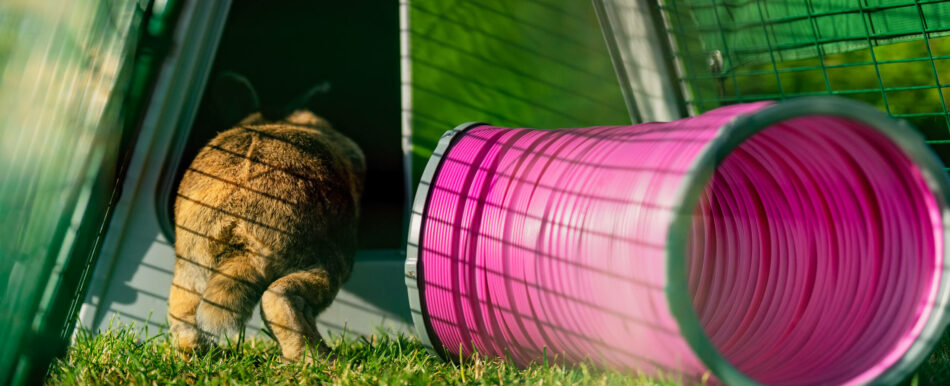

This entry was posted in Guinea Pigs
Thinking about adding small pets to your family, but caught up on the myths about keeping rabbits and guinea pigs? There are some common misconceptions about these pets that can sway new owners’ opinions of them. But we’re here to set the record straight and highlight the amazing attributes that these animals have to offer.
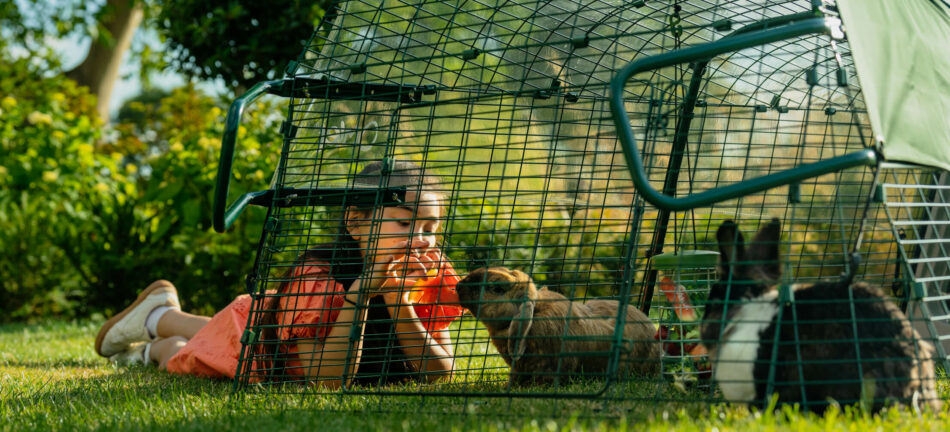
Rabbits
Rabbits make wonderful pets for owners of various ages and experience. They’re affectionate, intelligent, and are a joy to watch and interact with. But like all pets, bunnies have characteristics and preferences particular to their species that dictates their care, which has led to several myths surrounding them. Here are some of the most common myths about pet rabbits.
Myth: rabbits are low-maintenance pets for children
Fact: rabbits require daily care and careful interaction
Rabbits aren’t ideal for young children due to their care requirements and the skills needed to handle them safely. Their food and water should be refreshed daily, and they benefit from fresh greens and other rabbit-safe treats a few times a week. Bunnies also need their bedding changed regularly, otherwise they can suffer from flystrike — a serious condition that can result in death. Rabbits also need routine veterinary visits to have their teeth and nails trimmed if needed, and for general health checkups.
Their strong hind legs and sharp toenails make handling rabbits difficult for younger children. And, if startled or handled too roughly, rabbits can bite with their long front teeth. Because of these factors, rabbits should be primarily cared for by an older child or adult.
Myth: rabbits can live alone
Fact: rabbits need the companionship of other rabbits
Many people keep rabbits as solitary animals, but bunnies are very social animals that thrive in pairs or groups. In the wild, rabbits live in large family groups called colonies, and spend their days together. As pets, a pair of rabbits will groom each other, sleep together, and play throughout the day. Same-sex pairs are most successful with females or neutered males, or a spayed female and neutered male.
A singular rabbit can become depressed and listless, or even display negative behaviours like thumping, teeth grinding, or growling. To make sure bunnies live their lives to the fullest, it’s best to adopt them in pairs, or slowly introduce new rabbits together to form a bond. Once bonded, rabbits will live peacefully together for the duration of their lifespan.
Myth: rabbits love to be held and cuddled
Fact: most rabbits are nervous being held
As prey animals, rabbits are easily stressed being picked up and held. The act of lifting your rabbit simulates being snatched by a predator in the wild, and these instincts run deep. As a result, the majority of pet rabbits are not comfortable being held.
This doesn’t mean that you can’t interact or even snuggle with your bunny — you just have to let it be on their terms. Sitting with your rabbit and encouraging them to hop into your lap, or having them hop onto an elevated surface like a rabbit platform before picking them up will reduce the height from which they’re being lifted, making them feel less vulnerable. Slowly acclimating your rabbits to being held or picked up will help them gain confidence.

Guinea Pigs
Guinea pigs are loveable pets with big personalities. They’re adorable, vocal, and fairly easy going, making them ideal pets for owners of all ages — so long as an adult is the primary cavy caregiver. But their appearance and vocalizations have led to some common misconceptions. Here are popular myths about cavies, and what prompted such beliefs.
Myth: guinea pigs don’t need much space
Fact: cavies must live in pairs, and need plenty of space
Don’t let their compact size fool you — guinea pigs need plenty of space. They also need to be kept in pairs, as they form strong social bonds between each other. Always aim to provide as much space as possible with guinea pig runs and playpens.
Guinea pig hutches should be large enough to accommodate two cavies comfortably, and have an attached exercise area. Not only will cooped up cavies become bored, but guinea pigs are prone to being overweight, so exercise is essential. Plus, if you give your guinea pigs enough room, they’ll likely reward you with their trademark “popcorning” move.
Myth: guinea pigs are related to pigs
Fact: they are members of the rodent family
The exact origin of the name “guinea pig” isn’t clear, as they are neither from New Guinea, nor are they pigs. They originated from Peru, and are members of the rodent family. There are various theories as to how they got the first part of their name — from British currency to the trade ship route taken when importing them to other countries. The “pig” portion of their name comes from the vocalisations they make. Guinea pigs are also called “cavies” because the Latin name for them is Cavia porcellus, or “cavy” for short.
As members of the rodent family, they share some similarities with their distant cousins, mice, rats, and even capybaras, the world’s largest rodents. Guinea pigs have incisors (front teeth) that grow continuously throughout their lives, and round eyes on the sides of their head. They lack a noticeable tail, making them appear more like large hamsters or tiny capybaras.
Myth: guinea pigs have short lifespans
Fact: they can live up to 8 years with proper care
Rodents generally have short lifespans, but guinea pigs have life expectancies similar to those of rabbits — usually around 6-8 years. In contrast to domesticated guinea pigs, wild cavies, or “cuy” as they’re called in Peru, only have a life expectancy of 1-4 years. But in order to live a long, full life, guinea pigs need the right nutrition.
Guinea pigs can’t manufacture their own vitamin C, so it must be supplemented in their diet. Most commercial guinea pig feed is fortified with vitamin C, but you can supplement their intake with fresh foods like bell pepper or strawberry tops, or with fortified guinea pig treats. Be sure to treat your piggies sparingly, as they can become obese easily.
A myth about rabbits and guinea pigs
Myth: rabbits and guinea pigs can be kept together
Fact: this is true — to an extent
Rabbits and guinea pigs can be kept together, but only with experienced owners and under certain conditions. To keep rabbits and guinea pigs together, the following adjustments and practices must be adhered to:
- Guinea pigs need vitamin C in their diet, while rabbits can produce their own and may become ill if they live on a guinea pig diet. Rabbits also eat more and faster than guinea pigs, meaning cavies might miss out on meals. Always feed rabbits and guinea pigs separately.
- Rabbits and guinea pigs don’t speak the same language, so recognizing the body language of each is crucial to know when one species is stressed or is feeling threatened.
- All animals kept together should be spayed and neutered, but this is especially important when keeping different species together. Intact male rabbits especially can cause serious harm to guinea pigs trying to dominate or mount them.
Keeping these two species together is possible, if you have adequate space and separate feeding areas for each. Pay special attention to their personalities and assess whether separation is needed at any point in time.
Omlet and your rabbits and guinea pigs
No matter which species you keep, our rabbit and guinea pig hutches have been designed to support the needs and preferences of both bunnies and cavies. With customizable rabbit and guinea pig tunnels and outdoor pet runs, you can simulate their natural environment to help them get in touch with their innate behaviours. When you appeal to their wild side, you’ll be rewarded with healthy, happy rabbits and guinea pigs that will never cease to amaze and inspire you.
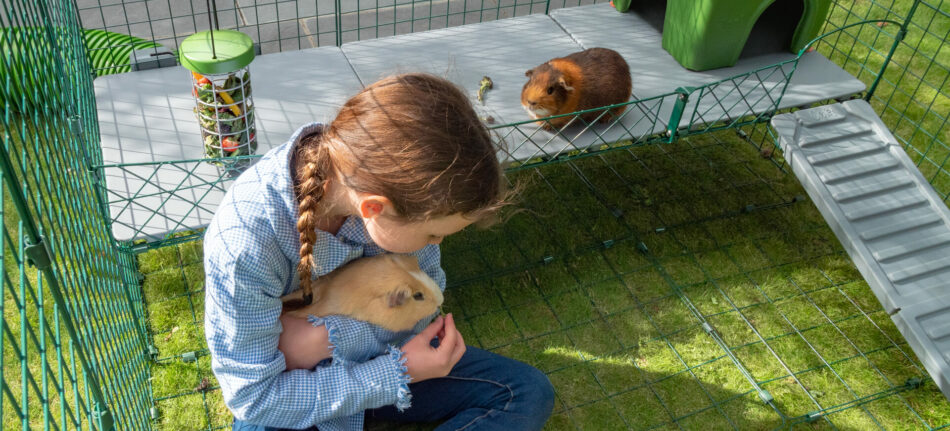

This entry was posted in Guinea Pigs
Keeping your rabbit or guinea pig cool in the hot weather is something that all small pet owners have on their minds this time of the year. Summer is a wonderful time to spend with your rabbits and guinea pigs, but the rising temperatures can cause stress — for you and your pets. Here are some tips and tricks to keep your rabbits and guinea pigs cool when temperatures soar.
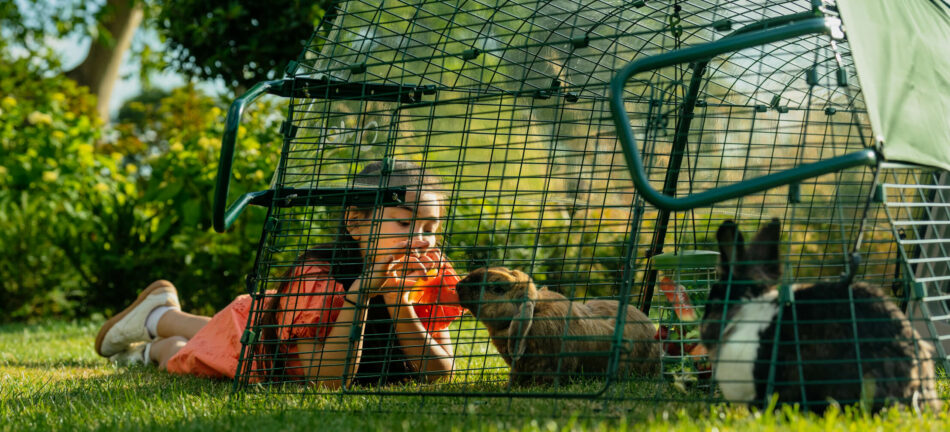
How hot is too hot?
First, it’s important to know when the temperature is simply too dangerous for your rabbits and guinea pigs to be outdoors. The answer of how hot is too hot is subjective to several factors, like:
- Your rabbit or guinea pig’s age and breed
- The ambient temperature vs “real feel” temperature (factoring in humidity)
- The amount of shade available
- How long the temperature will be elevated
As a general rule, you should watch for signs of discomfort from the heat in your rabbits and guinea pigs in temperatures above 85°F. Signs of heat stress in rabbits and guinea pigs include:
- Rapid or shallow breathing
- Open mouth breathing (panting)
- Drooling
- Lethargy
If left untreated, heat stress can quickly progress into heatstroke. Once your rabbit or guinea pig experiences heatstroke, there may be irreparable damage to their internal organs. Signs of heatstroke include those of heat stress, in addition to loss of consciousness or convulsions. If you think your rabbit or guinea pig is suffering from heatstroke, call your veterinarian right away.
How to keep your rabbits and guinea pigs cool
Thankfully, there are several ways to help keep your rabbits and guinea pigs cool in the summertime heat. These rabbit and guinea pig summer safety measures will help protect your pets from the heat, and allow them to spend more time outdoors.
An insulated hutch
Insulated rabbit and guinea pig hutches are the first line of defence against the heat. The Eglu Go Rabbit and Guinea Pig Hutch is twin-wall insulated with vents to provide airflow — which helps keep the hutch cooler than the ambient temperature. Choose a shady spot for your pets’ hutch to help it stay even cooler. When the temperatures really climb, add frozen water bottles inside of the hutch. Your pets will lay on them to cool off, and it will help to bring the interior temperature down even further.
Provide plenty of shade
Your rabbits and guinea pigs’ run should be shady to keep harmful UV rays and blistering heat off of your pets. Solid outdoor run covers keep the sun out, so that your rabbits and guinea pigs can cool down. Place water in the shaded areas to prevent algae growth, and to keep the temperature cooler. And, as with the hutch, add frozen water bottles around your pets’ shaded run to provide extra cooling relief.
Offer cooling hors d’oeuvres
Preparing frozen treats for your rabbits and guinea pigs can go a long way in keeping them cool. Here are some ideas for rabbit and guinea pig-friendly frozen treats:
- Fruit like bananas or strawberries
- Vegetables like green beans, corn, spinach, or broccoli
- Homemade frozen moulds or popsicles (with an applewood chew for a stick, or no stick) made from blended fruits and veggies
Add the frozen treats to a Caddi Rabbit and Guinea Pig Treat Holder to keep them fresh for longer, and hang it in a shady part of their run. You can also add ice cubes to your rabbits and guinea pigs’ water bottle to keep it at a palatable temperature.
There are refreshing treats that will help your rabbits and guinea pigs stay cool. These aren’t frozen, but they’ll help hydrate your pet, and when kept in the fridge, still provide a cooling effect.
- Apple slices
- Berries
- Lettuces
- Watermelon
Other heat-hampering techniques
There are a few other supplemental methods you can use to help beat the heat. Some of these include:
- Use a patio misting system around the top perimeter of your rabbits or guinea pigs’ run. Turn it on, or have an irrigation timer set for it to be on during the hottest part of the day.
- Install a large fan just outside of the run, or in the top corner of a rabbit or guinea pig walk in run. Make sure that your pets can’t reach any power cords or moving parts of the fan.
Use a combination of both of these for the strongest effect.
What to do when it’s too hot
Depending on where you live, your rabbit or guinea pig’s age and breed, and overall health condition, there may be times where staying outside is just too dangerous. These conditions are most likely to occur during a heatwave, or in areas that experience high humidity alongside soaring summer temperatures.
If you need to move your rabbit or guinea pig to cooler temperatures, try to keep them outdoors if possible. A well-ventilated garage, barn, or shed may be enough to keep their setup at a more comfortable temperature.
When shadier or cooler options just aren’t possible, you will need to bring your rabbits or guinea pigs inside. This shouldn’t be done lightly, as rabbits and guinea pigs that live outdoors year-round are accustomed to being in fluctuating temperatures. Bringing them into a stable environment will acclimate them to this type of temperature and they will need to remain indoors until the outside temperature is consistently lower.
It’s common for guinea pigs to be housed indoors, and placed outside for playtime. For these pets, outside visits should be limited to early morning and late evening hours during the summer to avoid the hottest part of the day. This is also true for rabbits housed indoors.
Omlet and your small pets
Summer isn’t without its challenges, but that doesn’t mean you shouldn’t be able to enjoy it with your pets. With our rabbit and guinea pig hutches, large outdoor rabbit and guinea pig runs, and outdoor run covers, you can provide plenty of shaded support for your pets throughout the summer. With an Omlet rabbit or guinea pig setup, you can enjoy a frozen treat together with your rabbits or guinea pigs, and rest easy knowing they’re being supported all summer long.


This entry was posted in Guinea Pigs
Looking for some inspiration for playtime with your small pets? There are several games you can play with your rabbits and guinea pigs that will be to the delight of everyone involved. From mazes to hide-and-seek, here are some pastimes that are sure to please your pets the next time you play.

The importance of play
Playing with your rabbits and guinea pigs builds their trust and confidence, which in turn helps you build a more meaningful and lasting bond with them. It’s amazing to see shy or timid pets come out of their metaphorical shells through playing with their humans. Being more active is good for their minds and bodies, and is one of the best ways to encourage your small pet to be more outgoing and physically fit. Through dedicated playtime, you’ll be able to forge an unbreakable bond between you and your rabbits or guinea pigs.
It’s also important to remember that rabbits and guinea pigs are prey animals by nature, so surprises, sudden movements, or loud noises can startle them easily. All of the games that you play with your small pets should be in a calm atmosphere, and with lots of treats to offer as tokens of encouragement and as rewards for their efforts.
Species-specific
Rabbits and guinea pigs differ in size and stature, so they each have their own set of skills that can be tapped into during play. For example, rabbits have long, powerful legs, so jumping over the sides of a homemade maze to fast-forward to the treat at the end is entirely within their realm of possibility. For the following activities, we will offer suggestions to modify each game based on the size and species of your pet.
Prepare a place to play
The best place to play with your rabbits and guinea pigs is in a safe and enclosed space. Outdoor rabbit and guinea pig runs are perfect for spending time with your pets during playtime. The enclosed space will keep them contained and comfortable, and gives you plenty of space to set up your games. Alternative play places are safe spaces inside your home — just make sure that the room you’re playing with your pets in is rabbit and guinea pig-proof.
Bowling
This game is more fitting for bunnies, but some guinea pigs may delight in barrelling objects over. Set up small bowling pins, like indoor sets designed for toddlers, and let your bunnies nose-boop them over. Reward your pets’ efforts with a treat before setting the pins back up for the next round.
Guinea pig modification: in relation to guinea pigs, even toy bowling pins may seem tall and intimidating — try setting up empty toilet paper tubes instead.
Magic cups
Show your rabbits or guinea pigs that you’re hiding a treat under an overturned plastic cup. Add one or two more overturned cups with nothing under them, then slide them around before allowing your pet to sniff out the hidden treat. Fresh herbs or other fragrant treats are perfect for this game.
Fetch
Think fetch is just for dogs? Think again — some rabbits and guinea pigs enjoy carrying small objects in their mouths. Try tossing small toys like balls, applewood chews, or pieces of cardboard for this game. To start out, toss the object just a few inches in front of your rabbit or guinea pig. If they pick it up, praise them, and offer a treat. Once they’re consistently picking up their toy, toss it farther out each time, and encourage them to bring it back to you.
Hide and seek
Rabbits and guinea pigs are curious by nature, so enticing them with some mystery will pique their interest. Lay on the floor and place your face in your hands. Your rabbit or guinea pig will come to investigate. Be careful not to startle your pet as you emerge, and be sure to offer them a treat for their cleverness.
Rabbit modification: hide under a soft blanket and call your rabbit. Bunnies love to burrow, so your rabbit will be thrilled at the prospect of digging in order to find you.
Maze running
Create mazes from cardboard boxes, building blocks, or other household objects with a treat placed at the end. Make sure that mazes are always placed at ground level, and that there are no small gaps or spaces for your pets’ feet to get caught in.
Rabbit modification: construct a maze from Zippi Rabbit Tunnels for the ultimate, reusable maze that your rabbits won’t hop out of.
Omlet and your rabbits and guinea pigs
From the rabbit or guinea pig hutch to outdoor runs and playpens, we’ve worked to create the perfect atmosphere for owners to spend quality time with their small pets. Design your own playground with Zippi Rabbit and Guinea Pig Tunnels, and add rabbit and guinea pig platforms to help your pets meet you on a whole new level. With Omlet, playtime isn’t just possible — it’s the pinnacle of quality time spent with your rabbits and guinea pigs.
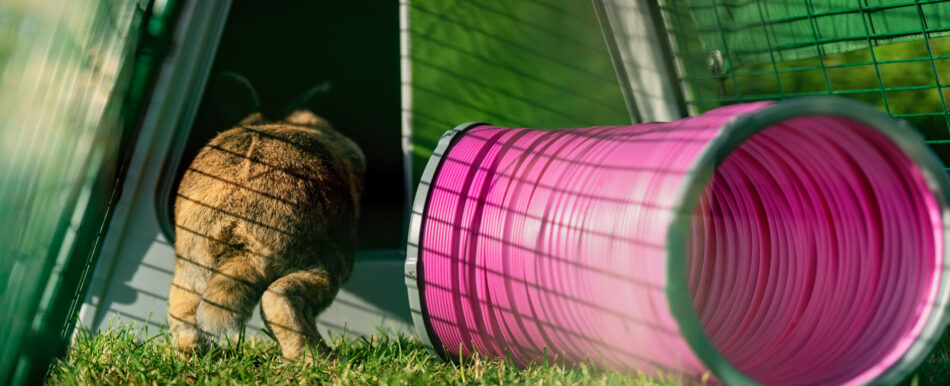

This entry was posted in Guinea Pigs
Exercise for rabbits and guinea pigs is important for their overall well-being, but it’s also a unique opportunity for you to bond and play with them. From playtime to training sessions, there are several ways to spend quality time with your rabbits and guinea pigs while benefiting their physical and mental health. Discover how much exercise your pets need, how to keep them fit, and how to build a bond through boredom busting activities with your rabbits and cavies.
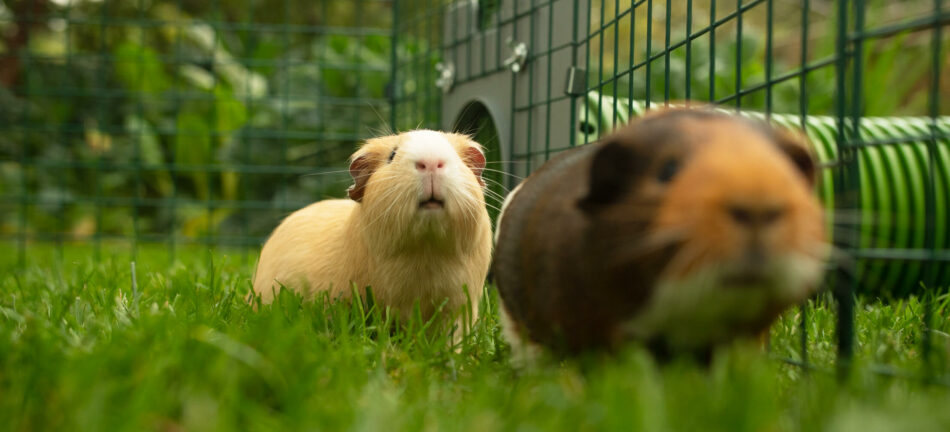
How much exercise do rabbits and guinea pigs need?
Rabbits and guinea pigs need to be able to exercise on their own, as well as doing activities with their owners. The amount of exercise needed for each pet varies and is dependent upon their genetics, diet, and environment. This means that these pets need spacious outdoor rabbit runs or guinea pig playpens to ensure they have ample space to run, hop, stretch, and explore.
Wild rabbits and guinea pigs are constantly on the move for their survival. This continuous need to move keeps them fit and spry — which are traits not always seen in their domesticated counterparts. While our backyard rabbits and guinea pigs may be distantly related to their ever-moving ancestors, their body compositions are still very similar. All rabbits have long, powerful hind legs, and guinea pigs are all potato-shaped with short legs and necks.
Guinea pigs are especially prone to being overweight, which puts strain on their small legs and joints. But rabbits aren’t immune to issues caused by lack of exercise — they too can become overweight, and are also prone to boredom if they aren’t properly stimulated. Bored bunnies can become depressed or develop destructive habits. By giving bunnies and cavies plenty of outdoor space, you’ll help them get enough exercise to keep them healthy and happy.
Encouraging your rabbits and guinea pigs to exercise
Fostering your pets’ natural behaviours is one of the best ways to encourage them to exercise. Because of their anatomy and natural instincts, rabbits need large, outdoor spaces to fulfil their need to run, burrow, and scratch. Zippi Rabbit Tunnels simulate burrows in the wild that rabbits run through, which will encourage your bunnies to explore and play. And while guinea pigs might not dig their own tunnels in the wild, they will happily use burrows dug by other animals — or in the case of domesticated guinea pigs, those provided by humans.
Guinea pigs can’t stand on their hind legs like rabbits can, so they appreciate a higher vantage point from which to view their world. Zippi Guinea Pig Platforms offer your cavies an elevated place to explore, and a shady, secluded space to hide beneath. The attached ramps encourage your guinea pigs to carry their weight at an incline, which strengthens their muscles and helps them maintain their figure.
Exercises you can do with your rabbits and guinea pigs
There are several ways to interact with your rabbits or guinea pigs while encouraging them to exercise. Some ideas include:
These are all fun ways to keep your pets fit both physically and mentally, while also providing you with a unique opportunity to build trust and confidence with them. Aim to incorporate half an hour of playtime with your bunnies and cavies once a day to help keep your pets bodies and minds stimulated. Playing with them doesn’t have to be robust, so any amount of interaction or movement that they would otherwise not be experiencing will build both a confident mind and strong muscles.
Exercises to avoid with your rabbits and guinea pigs
There is some equipment marketed for rabbits and guinea pigs that should be avoided, and some activities they shouldn’t participate in. These include:
- Exercise wheels or balls (similar to those for hamsters) marketed for rabbits or guinea pigs
- Leashes and harnesses
- Walks around your neighbourhood
While it might be tempting to take your rabbits or guinea pigs for walks on a harness, the vast majority of small pets find harnesses uncomfortable and alarming, so it’s best to play with your bunnies and cavies within the safety of playpens designed for them, or in a pet-proof area of your home. Rabbits and guinea pigs are prey animals, and as such can startle and bolt easily with sudden sights and sounds — the strain from them spooking on a harness can cause severe damage to their necks, backs, and legs.
Omlet and your rabbits and guinea pigs
From guinea pig playpens and outdoor rabbit runs, we’ve created safe and smart enclosures that allow your pets the freedom to move and explore. These spacious options also make it possible for you to join them in their endeavours — putting you front and centre in their lives. Watch your rabbits and guinea pigs explore through Zippi Tunnels, climb and meet you face-to-face with Zippi Platforms, and witness them experiencing the joy of fresh grass with mobile rabbit and guinea pig hutches. You, your pet, and Omlet are a winning combination for years of health and happiness to come.
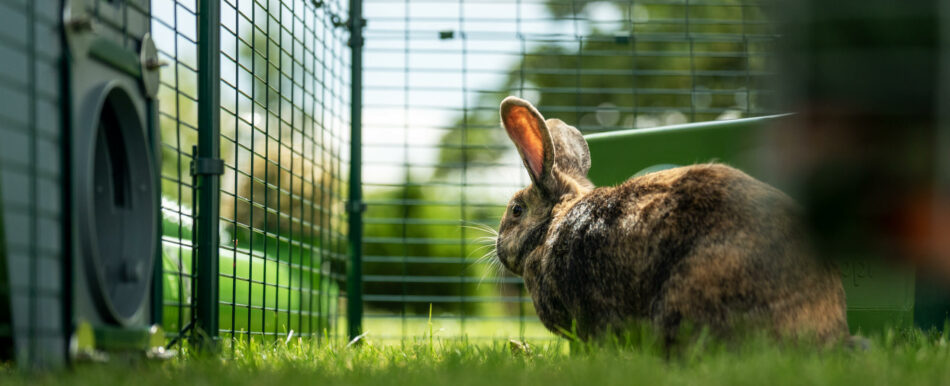

This entry was posted in Guinea Pigs
Spending time with your rabbits or guinea pigs is a great way to grow your bond with them, especially when there are toys involved. DIY toys for rabbits and guinea pigs are easy to make with materials that are probably already in your home. And these toys aren’t just for your pets — you’ll find that watching and interacting with your rabbits or guinea pigs through toys is both engaging and entertaining. Discover how making some of your rabbits and guinea pigs toys can be fun and rewarding.
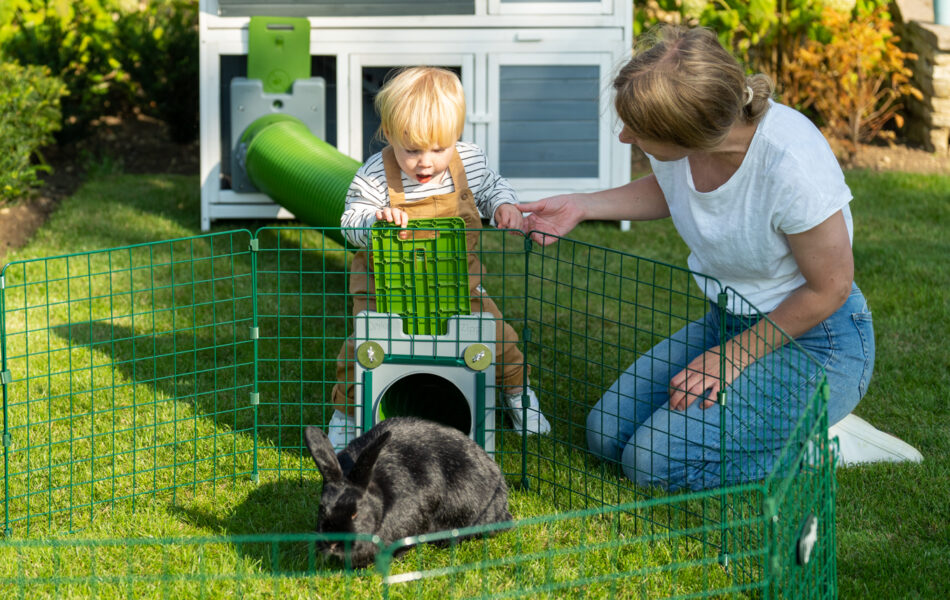
Why do rabbits and guinea pigs need toys?
First, it’s important to understand why rabbits and guinea pigs need toys. Think back to your childhood — you likely played with toys as a means of entertainment, but also to aid in the development and growth of your cognitive skills. The same is true for rabbits and guinea pigs.
Rabbits and guinea pigs are able to keep themselves active and entertained with toys, as well as grow their critical thinking and problem solving skills. These pets may be small, but they’re smart and enjoy objects to chew, toss, chase, or cuddle up with. There are several types of toys for rabbits and guinea pigs that can be purchased, but there are many that you can make at home.
How to play with your rabbits and guinea pigs
Playtimes are some of the best times with your rabbits and guinea pigs. Owners that play with their pets get to experience their individual personalities, and build a bond with them that lasts a lifetime. Through play, your pets will learn to trust you, and you’ll be able to identify their unique body language and needs.
Start by sitting on the floor or the ground with your rabbits or guinea pigs. Offering treats will help entice them to approach you if they are not already comfortable doing so. Introduce new toys one at a time so your pets aren’t overwhelmed. Show them their toy, maybe offering some movement if your pet is comfortable with it. Hang or place the toy in front of your pet, and watch them explore this new offering.
Some rabbits and guinea pigs can be taught to fetch small toys, while some are more interested in the aspect of chasing. Play around with different ways of interacting with your pets, like with Zippi Rabbit and Guinea Pig platforms to help you both see eye-to-eye.
Types of DIY toys for rabbits and guinea pigs
The most common types of toys for rabbits and guinea pigs include:
- Chews
- Activity toys
- Tunnels
- Forage boxes
- Hideouts
You can make your own versions of many of these toys using household objects, or with a short trip to your local hardware store. It’s important to remember to choose non-toxic materials for your pets’ toys. Never use treated lumber or paint for your rabbits’ or guinea pigs’ toys, and make sure that any cardboard or fabric is removed if your pets begin to nibble on them. And, it’s always a good idea to supervise your pets while they’re playing with their toys — especially if they are inclined or able to eat them.
DIY rabbit and guinea pig chews
Most rabbit and guinea pig chews are made from apple wood or compressed timothy hay, or a combination of the two. There aren’t many substitutes for apple wood chews for rabbits and guinea pigs, as they are the safest variety. But, by purchasing bulk apple wood sticks and timothy hay, you can craft your own chew toys by wrapping the sticks in strands of hay. Cut them to various lengths, and create different shapes for variety. Sisal rope can also be used to wrap apple chews and hay together — just remember to remove the toy as soon as the rope becomes frayed or gnawed.
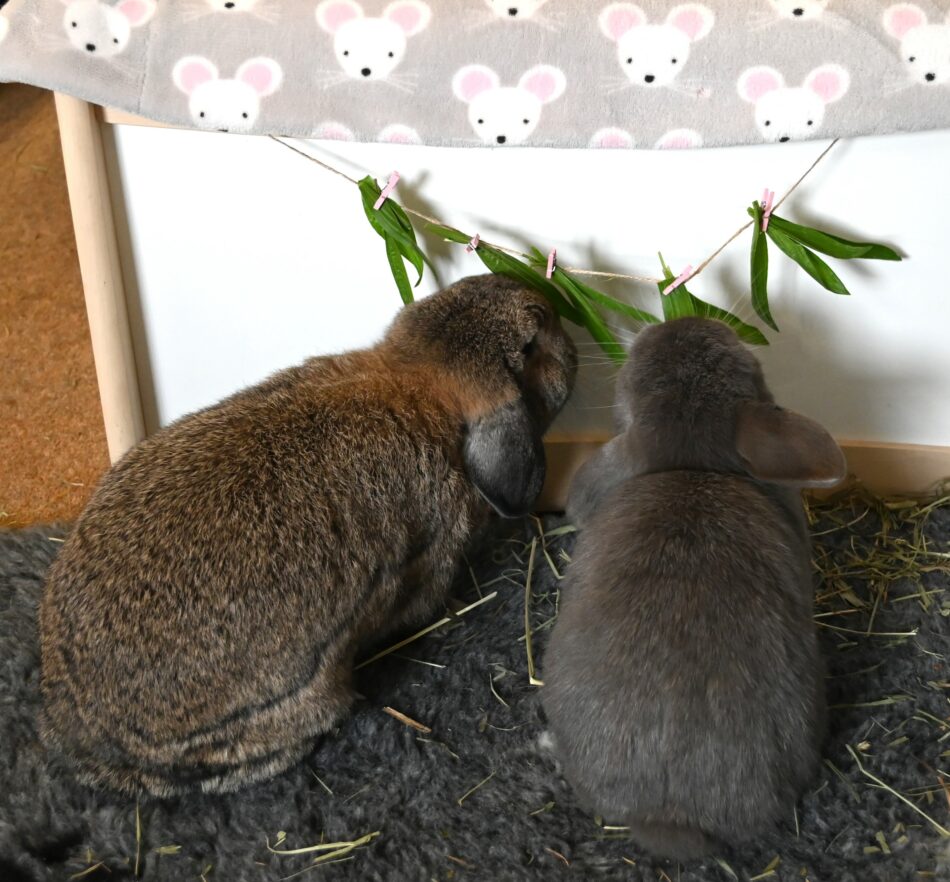
DIY rabbit and guinea pig activity toys
Activity toys are those that hang from your rabbit and guinea pig run. They’re designed to encourage your rabbits and guinea pigs to stretch, nudge, or tug. Most of these toys are made from apple wood and sisal rope, which are safe options for your pet. Experiment by making spiral or branch shapes, or by threading alternating pieces of apple wood with other edible treats like rabbit and guinea pig-safe fruit or veggies.
You can also hang a Caddi rabbit and guinea pig treat holder in their run to encourage the same activity. The Caddi reduces waste, and has lots of room for your pets’ favourite treats.
DIY rabbit and guinea pig tunnels
Rabbit and guinea pig play tunnels that are made for small pets will hold up better than DIY alternatives. Some owners make tunnels from drainage tubing, but the small holes designed to release water pose a risk to your pets’ feet. A Zippi Rabbit and Guinea Pig Tunnel System is the best investment when it comes to fostering natural burrowing behaviours in both pets. The safest way to create temporary tunnels for your rabbits and guinea pigs in the meantime is to use boxes connected end-to-end.
DIY rabbit and guinea pig forage boxes
A shallow storage tote or livestock feed bin makes an excellent base for a forage box for your rabbits and guinea pigs. Pour 1-2 inches of sand or top soil into the container, or add scraps of recycled cardboard or paper to create a substrate for your pets to dig through. Rabbits in particular will appreciate the opportunity to dig in soil. Once you’ve added a layer of substrate, toss small toys, chews or treats into the box and watch your pet forage for their findings.
DIY rabbit and guinea pig hideouts
There are several ways to create hideouts for your rabbits and guinea pigs. As prey animals, they both appreciate the opportunity to hide when they’re tired, overwhelmed, or during games of chase with each other. Rabbit and Guinea Pig Shelters are specially designed to create a safe haven for your small pets, and are the best option to be kept with their rabbit or guinea pig hutch and run. But, short play sessions, or additional options can be created with cardboard boxes, overturned plastic plant containers with an entrance cut into them, or with other creative alternatives. Just remember not to use treated materials, and be aware that DIY options are not weatherproof, and should not serve as a substitute for their hutch.
Omlet and your pets
From rabbit and guinea pig hutches, to outdoor rabbit and guinea pig runs , discover how your pets encounter their world when you’re able to take an active role in it. Explore with them, encourage them, and most of all, enjoy them on a daily basis when you have rabbit and guinea pig products that have been designed to bring you closer than ever.


This entry was posted in Guinea Pigs
Thinking about adding a small pet to your family? Despite having different needs, rabbits and guinea pigs require many of the same accommodations, so whichever you’re considering adding to your family, your shopping list will look similar. From hutches and runs, to play and feed, we’ve got the ultimate rabbit and guinea pig checklist for you to tick off before you bring your fluffy new friends home.

Caring for rabbits and guinea pigs
Rabbits and guinea pigs both make wonderfully rewarding family pets. They can be housed indoors or outdoors in suitable climates; either way they need plenty of room to roam and certain equipment to stay safe, happy and healthy. With the appropriate setup and care, rabbits and guinea pigs can live up to 8-10 years.
Rabbits and guinea pigs have different nutritional needs and communication methods, so should be kept separately. They’re both social animals however, and need the companionship of their own kind. So, when planning your pets’ future home, make sure you can provide room and care for at least two of either.
Hutches
Traditionally, rabbit and guinea pig hutches have been made of wood, but this poses a few problems. Both rabbits and guinea pigs have teeth that grow continuously. They need to gnaw almost constantly in order to keep their incisors from over growing, which leads to serious health problems. Wooden hutches are tempting to chew on, and treated lumber can be toxic to pets. They’re also drafty, inadequate in more extreme weather, and absorb moisture, ammonia and odours, so can become unhygienic and need replacing in no time at all.
Eglu Go Rabbit Hutches and Eglu Go Guinea Pig Hutches are designed to give your small pets the safety and comfort they need and deserve. They are both also designed to be used in conjunction with fixed, steel mesh runs, giving your rabbits or guinea pigs free access to an outdoor space (more on this below.)
- Made of pet-safe, strong, durable plastic
- Twin insulated for optimal internal temperatures
- Draft-free ventilation
- Easy to clean in a matter of minutes
- Predator proof design
- Built to last a lifetime
Starting out with a durable, easy clean rabbit or guinea pig hutch is an investment you will soon recoup, which will set you and your pets up for success from the first day.
Bedding
The bedding you use inside of your rabbits’ or guinea pigs’ hutch should be natural and absorbent. Typical bedding options include:
- Pine shavings or pellets
- Aspen shavings
- Recycled paper (this resembles loose cotton)
- Straw
Breeds of rabbits with long hair like Lionheads or Angoras need recycled paper or pine pellets as bedding – straw and shavings will get tangled in their coats. Similarly, breeds of guinea pigs with long hair like Peruvians or Shelties should not be kept on shavings or straw bedding.
Outdoor space
Rabbits and guinea pigs need plenty of space outside their hutch to stretch their legs and explore, which they should ideally have constant, secure access to. Rabbits in particular have lots of energy, so a spacious outdoor rabbit run is essential to helping them stay healthy and happy.
If you’re short on outdoor space, the Omlet Zippi Tunnel System is a great way to recreate their natural environment and let them zoom when the mood takes them, as it lets you connect their hutch to additional enclosures in different areas, as a burrow would. Guinea pigs also need an outdoor guinea pig run to stay fit and can also benefit from a tunnel system, as they can be prone to obesity and boredom if they don’t have enough space to exercise.
Omlet’s rabbit and guinea pig runs have attached floor panels to prevent digging out, which is an issue in particular with female rabbits, but is also necessary to prevent predators digging in.
Constructed of weatherproof, heavy-duty steel weld mesh, Omlet runs have a modular design that lets you expand your run when you like, making them a future proof choice.
Enriching their area
Part of the joy of having rabbits or guinea pigs is watching them play. The best rabbit and guinea pig toys are those that encourage their natural behaviors. Rabbit and guinea pig run accessories, like shelters, play tunnels and platforms make perfect places for your pets to stretch their legs, find a shady spot for a snooze, or just hunker down for some quiet time. Since both rabbits and guinea pigs are prey animals, they’re naturally nervous and always on high-alert for potential predators. Shelters and tunnels they can retreat into quickly if they perceive danger give them a sense of security, so placing these throughout the run will help your rabbits or guinea pigs feel much more at ease.
Food
Both rabbits and guinea pigs should be fed high quality pellets as per the instructions on the pack. However, unlike rabbits, guinea pigs can’t manufacture their own vitamin C, so commercially available guinea pig pellets should be fortified with this essential nutrient. Their different dietary needs are one of the main reasons rabbits and guinea pigs should be kept separately.
An essential part of their wellbeing is plenty of timothy hay, which both rabbits and guinea pigs need free-choice access to around the clock. This keeps their digestive system working as it should, but also helps keep their teeth trimmed. Timothy hay won’t cause rabbits or guinea pigs to become overweight, so it’s safe (and necessary) for it to be available at all times.
Both bunnies and cavies will most likely enjoy the odd fresh crunchy treat. Leafy greens, chunks of raw broccoli or cabbage, fresh herbs and small amounts of some fruits will have them hopping over for a nibble. Keep these treats off the ground with a Caddi Rabbit and Guinea Pig Treat Holder to keep them fresher for longer and discourage pests.
Omlet and your rabbits and guinea pigs
Keeping rabbits and guinea pigs is a rewarding experience for all ages, but despite their diminutive size, these cuties need daily care and attention. Our Eglu Go Rabbit and Guinea Pig Hutches are designed to make providing your small pets with a hygienic, comfortable home a breeze. With cleaning done and dusted in a matter of minutes, you can spend your time enjoying their quirky characters, sociable natures and natural curiosity.


This entry was posted in Guinea Pigs
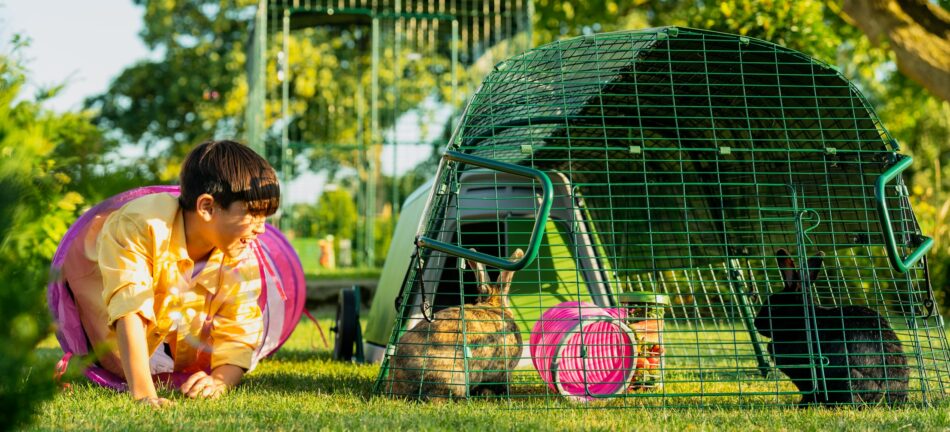
Wondering how to pick the right hutch for your rabbit or guinea pig? It’s easy to get bogged down by all of the choices available for potential and current cavy or rabbit owners. We’ll help you decide how to pick the right home for your small pets, and how to help them enjoy it to the fullest.
Picking the perfect hutch
There are some important factors to consider when picking the right hutch for your rabbit or guinea pig. The materials, size, and placement of their home will greatly influence how you care for your furry friends, so need careful consideration. With these guidelines, you’ll be able to select a hutch that fits all of your needs.
Indoor or outdoor
Rabbits and guinea pigs can be kept indoors, but they are just as happy outdoors in an insulated hutch with a spacious run to give them plenty of room to run and play. If left to roam the house, rabbits and guinea pigs will happily find cords, wires, baseboards, or other items to chew on. And while they can be litter box trained, you’ll likely be sweeping up fecal pellets on an hourly basis. An outdoor setup makes cleanup a breeze, and you won’t need to worry about your pets nibbling on something they shouldn’t.
Housing your rabbits or guinea pigs outdoors year round is not only possible, but made easy with insulated hutches. Rabbit and guinea pig hutch weather protection can be added as an additional layer of insulation during frigid temperatures, and run covers provide shade and protection from the rain.
It should be noted that not all rabbit breeds and guinea pig breeds will thrive outdoors — especially in extreme climates. Guinea pigs in particular are suited to a milder climate, whereas many rabbit breeds do well outdoors. However, bringing them in and out is not good practice, as they will acclimatize to one or the other and won’t cope well with sudden changes in temperature. Breeds that require careful observation when housed outdoors:
Rabbits
Guinea Pigs
Consider size
Rabbits and guinea pigs are very social animals, and need friends of their own kind. While you can keep rabbits and guinea pigs together successfully, they each have different dietary needs and require their own space, so it’s best to start out with one species at a time, and always in pairs. Spayed and neutered males and females are good pairings, as are same-sex pairings (though rabbits should always be spayed or neutered in same-sex pairings to avoid territorial scuffles).
A home for your rabbits and guinea pigs is much more than just a hutch for shelter and sleeping — they should also have a run large enough for them to run and play in. As with other pets, both rabbits and guinea pigs benefit from the most space possible. Providing extra space through Zippi Tunnel Systems and Zippi Play Pens gives you an opportunity to customize your pets’ setup and offer them plenty of space outside of their hutch without sacrificing safety.
Give yourself some space
Don’t forget to factor in spending time with your rabbits or guinea pigs when choosing their hutch. Give yourself plenty of space to access their food and water for easy refills, and space in the run to spend time with them. If crawling or reaching into a run won’t be feasible for you, consider adding a rabbit and guinea pig playpen to their setup for easy access and quality time together. A Walk In Run is also a great addition if you have space, as it makes spending time with your small pets particularly comfortable, and gives easy access for cleaning or for switching their set up around for variety in their play and exercise.
Materials matter
Traditionally, rabbit and guinea pig hutches have been made from wood. It’s a readily available, inexpensive material that gets the job done. But, over time wood will rot, shingled roofs will need repairing or replacing, and hardware cloth will pull away from wood staples. And, wood is a very enticing material for rabbits and guinea pigs to gnaw on, which poses a risk not only to the structural integrity of the hutch, but to your pets’ health as well. Treated wood can be toxic when ingested, and splinters or large pieces of wood can cause obstructions in your pets’ digestive tract. Wood also absorbs ammonia from urine, and is difficult to keep hygienic, even with lining such as card or paper, as this too will soak through and be shredded by busy paws.
Plastic rabbit and guinea pig hutches don’t rot, warp, need re-roofing, or pose a gnawing risk to your pets. They’re weather resistant, don’t absorb moisture or odours, and can last a lifetime. And, instead of hardware cloth held in place with staples, the attached runs of Omlet’s rabbit and guinea pig hutches are made of heavy duty welded steel mesh that are held in place with strong, weather resistant clips. The Eglu Go Rabbit and Guinea Pig Hutch is easy to clean, and can be moved with ease with the addition of optional wheels and handles. Over time, this makes opting for an Eglu Go a great investment – financially but also in terms of time. With a slide out try you can simply wipe clean, you will be able to keep their hutch shipshape in a matter of minutes.
Accessorize their home
Once you’ve picked out your rabbits’ or guinea pigs’ hutch and run, it’s time to accessorize. Elements like treat holders, Zippi Platforms, and shelters and play tunnels are all ways to keep your small pets entertained, engaged, and enriched in their environment. They also help you interact with your pets on a whole new level, and build the bonds between you that last a lifetime.
Omlet and your rabbits and guinea pigs
We didn’t want ordinary hutches for extraordinary pets — so we created rabbit and guinea pig products that defy the norm. Our products also aim to bring you closer than ever to these animals that have captured the hearts of so many. From easy to clean hutches, spacious outdoor runs, and the one of a kind Zippi tunnel system, you’ll be amazed at how fun and intuitive it can be to interact with your rabbits and guinea pigs.
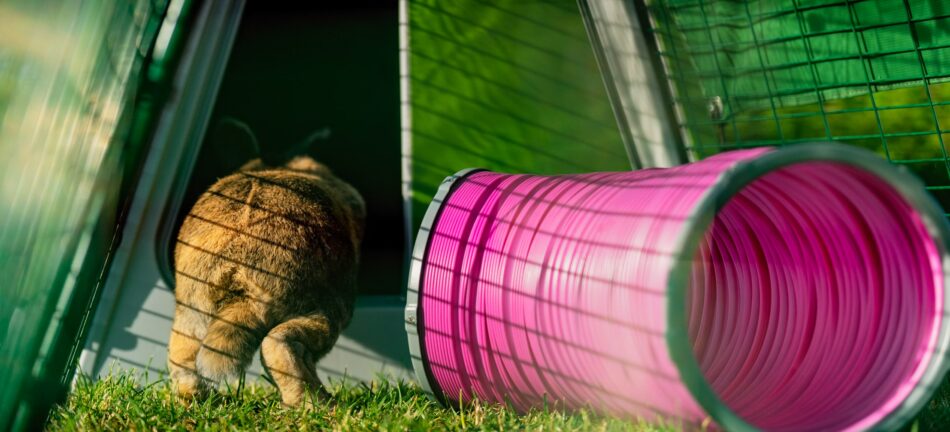

This entry was posted in Guinea Pigs
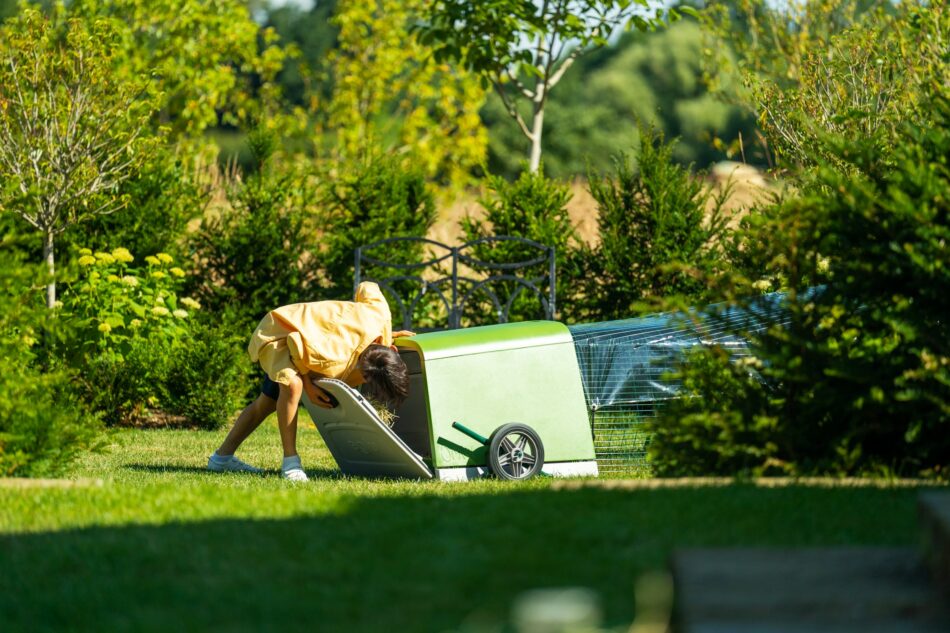
New guinea pig parents often find themselves wondering why their piggies hide. Are they scared? Shy? Stressed out? There are many reasons why cavies seek undercover solace — most of which stem from natural behaviours instead of external stressors. So why do guinea pigs hide? We’ll explore the reasons why guinea pigs hide, so that you can gain a better understanding of this innate behaviour.
Danger ahead
Guinea pigs are prey animals, so they’re on constant alert for potential threats. Wild guinea pigs have to keep an eye out for predators as a means of survival, but this natural behaviour remains strong in domesticated cavies. Being low to the ground, everything that’s taller than themselves may be perceived as a threat — which is just about everything aside from other guinea pigs.
Cavies have eyes set high up on the sides of their heads, giving them excellent vision to spot aerial threats. They’re also very intuitive when it comes to shadows or other movement that may clue them into a potential threat looming.
Your guinea pigs’ natural response to perceived danger is to run for cover. Cavies in the wild burrow in the dens or tunnels of other animals, or hide in thickets, under rock formations, or along the forest floor. So, in captivity, your guinea pigs will seek out the nearest shelter when they are alerted to potential danger. Giving them guinea pig play tunnels is a great way to simulate these pre-made burrows.
Other family pets may create this perceived threat response from your guinea pigs. Dogs, cats, or even pet birds can send your cavies to the nearest cover. Be sure to introduce your guinea pigs to your other pets slowly and on your cavies’ level to make them more at ease, creating a positive experience from the start.
Boredom
On the flip side of being overly alert, a depressed guinea pig can hide out of sheer boredom or low spirits. If cavies don’t have company or things to keep them busy, they may become listless and retreat to the same spot day after day.
Having an interesting and engaging habitat will help prevent boredom in guinea pigs. Providing guinea pig ramps and platforms, or using a Caddi Guinea Pig Treat Holder to elevate their favourite snacks are great ways to incorporate variety and exercise into your cavies’ daily routine.
Rearranging your guinea pigs’ run routinely will stimulate their minds and bodies. Try moving their hideouts around the run, changing up their Zippi Guinea Pig Tunnel System route, and adding new toys regularly.
Adjusting to a new setting
Guinea pigs are most likely to hide when they’re in a new environment. If you’ve just welcomed a new guinea pig, don’t be surprised to see them spend the majority of their time hiding out during the first week or two. This is especially true of adopted guinea pigs that have a complicated history with humans.
Cavies crave companionship, so it’s best to obtain guinea pigs in bonded pairs. If you’re introducing new guinea pigs, be sure to do so slowly and through a barrier so that they can warm up to each other. Don’t be surprised if your previously outgoing guinea pig hides in response to a newcomer – this is natural.
Sudden movement or loud noises
Even healthy and confident guinea pigs that have been part of your family for an extended amount of time will naturally dart for cover when they encounter sudden movement or loud noises. This is completely normal and is actually a sign of good cognitive reasoning in your guinea pigs. Much like a reflex, guinea pigs will startle at unexpected sights and sounds.
Try to keep your guinea pigs in a low-traffic area of your home or garden to avoid triggering this response constantly. While it might not be possible to eradicate all causes of sudden movement or loud noises, effort should be taken to reduce your cavies’ exposure to them.
Shyness
Not all hiding behaviour is rooted in natural behaviour or stress – some guinea pigs are just shyer than others. This has more to do with their individual personality than their environment. As long as your shy cavy comes out to play with their companions, to eat and drink, or is seen exploring (albeit, cautiously), it’s safe to conclude that their personality is just more on the introverted side.
Shy cavies benefit most from opaque guinea pig hideouts, or even DIY “curtains” made from strips of fleece along the front of their favourite hiding place to help them feel more comfortable. Avoid using transparent hiding structures, or those with large openings for reserved guinea pigs, as these won’t be as comforting to them.
Should you be concerned by your guinea pig’s behaviour?
Hiding is completely normal and natural in cavies, but there are times when extended or sudden episodes of hiding can point to a health concern. Cavies that aren’t typically shy and suddenly spend hours a day hiding, or any guinea pigs that aren’t coming out to eat or drink should be monitored closely.
A number of health concerns could cause your guinea pig to want to hide the majority of the day, but some of the most common reasons are:
- A urinary tract infection (UTI)
- Upper respiratory infection
- Gastrointestinal problems
- Neurological disorders that cause imbalance or poor vision
- Old age
If your cavies are hiding regularly and not engaging in normal activities, it’s time to contact your veterinarian.
How to get your guinea pig out of hiding
Guinea pigs that are potentially ill should not be left to hide for more than 24 hours, whereas cavies adjusting to a new home should be given a minimum of two weeks to fully acclimate. It’s always best to let your guinea pig come out of their hiding place on their own, but some situations dictate the need to move them yourself. If you need to remove your guinea pig from their hiding spot, be sure to do so safely and in the least stressful way possible.
- Close off the entrance to their hide by either closing the door (if possible) or sliding a solid object in front of it
- Gently lift the hideout or reach into their hiding spot and grasp them as you normally would to lift them – supporting their entire body in the process
- Hold your guinea pig securely against you to help them feel safe
Omlet and your guinea pigs
Our guinea pig products are designed to foster cavies’ natural instincts – hiding included. The Eglu Go Guinea Pig Hutch is the perfect piggy hideout with convenient human access if needed. And, our line of Zippi Guinea Pig Shelters, Guinea Pig Play Tunnels, and Zippi Guinea Pig Tunnel Systems offer your cavies several comfortable options to hide and hang out while encouraging physical movement and mental stimulation. At Omlet, we bring nature to your own garden and blend it with ways to deepen the bond between you and your guinea pigs.
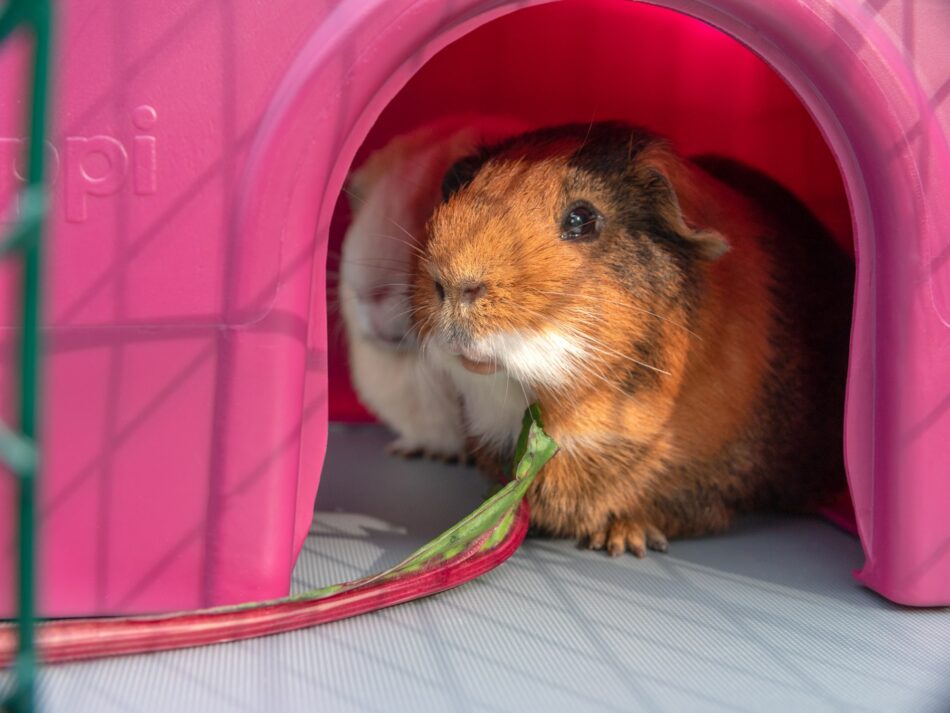

This entry was posted in Guinea Pigs
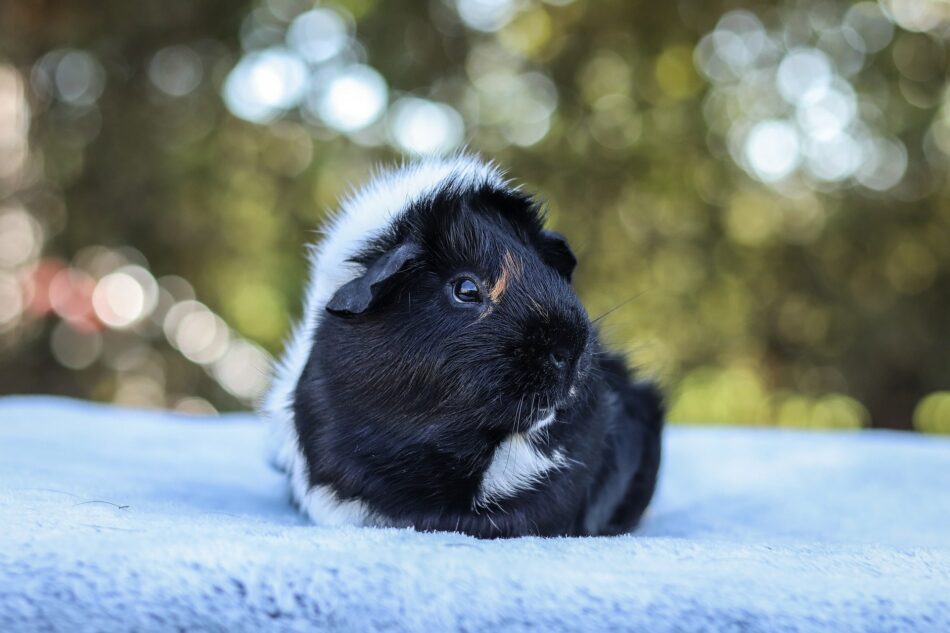
Winter wonderlands may appeal to some people and animals – but guinea pigs do not like the snow. In fact, because of their physiology and origins, snow can be dangerous for cavies. See how to protect your guinea pigs this winter from the snow, and how to help them enjoy the chilly season ahead.
Why do guinea pigs dislike the snow?
Guinea pigs trace their lineage back to wild cavies in South America. While our domesticated piggies are far removed from their wild cousins that still roam this area, their physiology hasn’t changed much. Because their native habitat is a temperate climate, guinea pigs are sensitive to extreme temperatures. The freezing temperatures that create snow, and the snow itself are both a threat to your cavies’ health and safety.
The dangers of snow to guinea pigs
Even if your guinea pigs are accustomed to living outdoors, winter precipitation poses a large threat to their safety. Here are some of the reasons why snow can harm your cavies.
Frostbite
Frozen precipitation can spell frostbite quickly for uncovered body parts. Guinea pigs have naked feet that are susceptible to frostbite if they have to stand in the snow for an extended period of time. Anything more than a few moments of contact can chill your cavies’ feet to the point of frostbite. If you suspect your guinea pig has frostbite, you should contact your veterinarian right away.
Hypothermia
While it’s not specific to the snow, hypothermia can occur quickly in cavies that are both cold and damp. Hypothermia sets in when a guinea pig’s body temperature drops below 35 degrees °C. Symptoms of hypothermia in guinea pigs include:
- Shivering
- Lethargy
- Pale limbs that are cool to the touch
Cavies that have gotten too cold should be brought into a warm space quickly, but caution should be taken that they aren’t warmed up too quickly to avoid sending them into shock. Wrap them up in a blanket or towel and bring them inside, while rubbing their bodies vigorously. Hypothermia is a medical emergency in guinea pigs, and you should always call your vet if your cavy displays any symptoms.
Reduced access to food and water
Another winter weather struggle is keeping the path to your guinea pigs’ food free of snow, and keeping their water thawed. Frozen paths or snowy treks to get to their food with increase your cavies’ risks of contracting frostbite or hypothermia.
Feeders should be elevated to prevent snow from blowing into their feed, and water bottles should be rotated throughout the day, being replaced with warm water. You can also wrap water bottles to insulate them against the cold. Open-top containers of water can have bird bath heaters submerged in them to prevent them from freezing — but be sure that any electrical cords are out of your cavies’ reach.
Guinea pig snow safety tips
Guinea pigs can fare outside in the snow if certain conditions are met. But, if the temperatures are below freezing for an extended period of time, or if your area receives heavy snowfall, it may be best to bring your guinea pigs inside for the winter.
Proper housing
An insulated, draft-free guinea pig hutch can go a long way in keeping your cavies safe in the cold. Omlet’s Eglu Go Guinea Pig Hutch is designed for year-round use and comfort, while providing a snow-free reprieve from the elements. Use deep bedding like straw and provide fleece blankets inside of the hutch for your cavies to burrow into for extra warmth.
Add layers
Extreme weather jackets can be added to the Eglu Go Guinea Pig Hutch for an added layer of insulation. These hutch covers keep snow and ice off of the hutch, keeping the interior temperature more stable. And, with full coverage, the doors and latches of the hutch will remain accessible and frost-free.
Reinforce their run
You can keep snow out of your cavies’ run by covering the top and sides. Our guinea pig run covers are heavy-duty, and effectively keep precipitation out of the run. Choose clear covers to allow warming rays of sun in while keeping the snow out, or solid covers to give your guinea pigs the feeling of privacy when they venture out in the winter air. Or, combine both types of tarps for the best of both worlds.
Do some guinea pigs fare better than others?
The same safety measures should be taken for any breed of guinea pigs. While cavies have a variety of coats, there are no distinct advantages of a certain type or texture of fur. Longer-haired guinea pigs may be better insulated than short-haired breeds, but as long as your guinea pigs are used to living outdoors, they’ll have moulted and regrown a new winter coat that’ll help insulate them against the cold. The main goal is to keep your cavies’ coats dry so that they’re able to maintain their insulating properties.
The exception to this is the Skinny Pig breed. These hairless cavies have no coats at all to protect them from extreme temperatures, and should only be kept outdoors during moderate weather.
Omlet and your guinea pigs
Guinea pigs might not like the snow, but they can enjoy their time outside this winter in an Eglu Go Guinea Pig Hutch. Keeping a close eye on your cavies during the cooler weather will help ensure they’re enjoying their time outside and prevent health conditions brought on by the snow. And, with Omlet, your guinea pigs can nestle in their insulated hutch — comfortably dreaming of the snowless days to come.
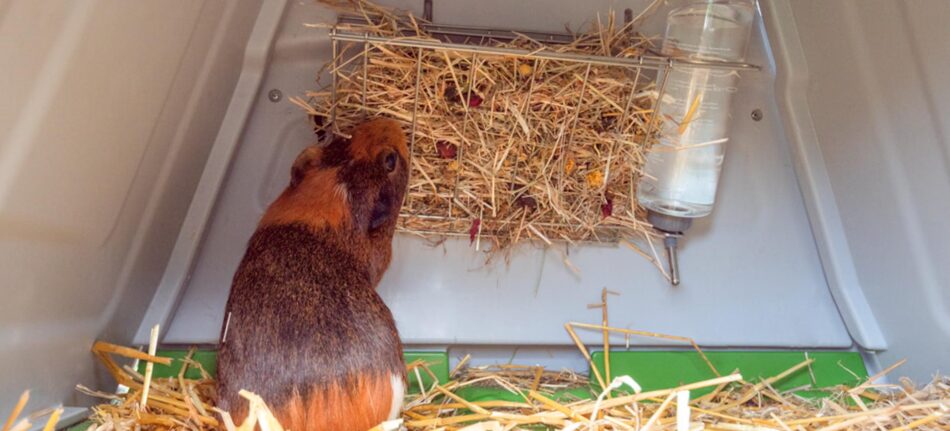

This entry was posted in Guinea Pigs

Like many other pets, guinea pigs moult twice a year. This process of shedding their old coats and putting on a fresh coat for the season is natural, and may be more noticeable in some cavies than others. Find out if the fur you’re finding in your guinea pig’s home is part of this seasonal shed, or if the condition of your cavy’s coat points to something else.
Why do guinea pigs shed?
The seasonal shedding event is called “moulting,” and nearly all animals that have fur or feathers moult. Guinea pigs will typically moult twice a year: in the spring and early autumn. The spring shedding session is to prepare for the warmer weather ahead, while the autumnal moult allows guinea pigs to grow thicker fur for the winter. As the days grow longer or shorter and the temperatures begin to fluctuate, cavies are cued to start their seasonal transformations.
Outdoor guinea pigs may exhibit a more exaggerated shedding pattern, as they will take their cue to shed from the sun and the weather. It’s not unusual to see a lot of fur in your guinea pig’s hutch or run, and as long as you don’t notice bald patches, this hair loss is perfectly normal during a moult. With this rapid shedding and regrowing of fur, it should take your cavy between 2-6 weeks to complete a moult.
Indoor guinea pigs may shed more gradually throughout the year, as they aren’t exposed to as much sunlight or changes in temperature as their outdoor counterparts. This may make it seem like indoor cavies shed constantly – which is due to a very slow moulting cycle. Since they don’t feel the urgency that outdoor guinea pigs experience when growing a new coat, they will slowly shed old fur throughout the year, which results in daily shedding in small amounts.
Moulting takes a lot of energy, so you may see your guinea pigs sleeping more than usual. They may also be more hesitant or less tolerant of being handled. This is due to hair follicles putting pressure on their skin, which can cause minor discomfort. You may also notice your guinea pigs scratching or rubbing their coats along their hutch or run to help rid their coats of loose hair.
Do all guinea pigs shed?
Nearly all breeds of guinea pigs shed – except hairless varieties. You can usually tell by looking at your cavy’s natural coat how much they will shed. Guinea pigs with long or dense hair will have a more dramatic shedding pattern than short-haired breeds. Breeds that will typically have the most prominent shedding include:
Skinny pigs are a breed of hairless guinea pigs that will not moult, unless they have small tufts of fur. However, since they lack natural insulation, they should be kept in a climate-controlled setting to help them keep their body temperatures regulated. Skinny pigs aren’t good candidates to be outdoor cavies – except during temperate weather.
How to care for your cavies during heavy shedding
Caring for your cavies during a moult isn’t much different from their ordinary daily routine. But, there are a few things you can do to help them feel more comfortable and to reduce your guinea pigs’ shedding.
Grooming
Brushing your guinea pig can help control shedding by ridding their coat of loose hair. Fur that has been shed from the skin can cling to the surrounding coat and create an irritating buildup of more hair and debris. Since long-haired guinea pig breeds are more susceptible to matting under normal conditions, it’s especially important to brush them regularly while they’re moulting to prevent knots and mats from forming.
Grooming your guinea pig also gives you an opportunity to do a quick health check with them. While you brush your cavy, check for:
- Weight loss or gain
- Lumps or bumps
- Overgrown toenails or teeth
- Parasites in their coat
- Flaky or inflamed skin
- Discharge from their eyes, ears, or nose
Nutrition
Moulting takes extra energy, so nutrition is important while your cavy is growing in a new coat. Guinea pigs should always have constant access to timothy or orchard grass hay and a hay-based pellet diet. Since cavies can’t manufacture their own vitamin C, be sure their feed is fortified with this essential nutrient – which is also essential for a healthy hair coat. This is a necessary component of your guinea pig’s diet all year round, but is especially important during a moult to grow a healthy, vibrant new coat. Providing your piggies with a vitamin C supplement in addition to their regular feed during the moulting season is perfectly safe, so long as you don’t exceed levels of 100 mg/kg daily.
Fresh water should also be available at all times. If your guinea pig drinks from a crock, be sure to skim the shed hair from it daily. Water bottle nozzles may also catch loose hair that is blown around, and can clog or leak if the fur interferes with the stopper.
Environment
Keeping your guinea pig’s hutch and run clean and stress-free is essential to helping them through a moult. The Eglu Go Guinea Pig Hutch is easy to clean thoroughly in just minutes, and offers convenient access to your cavy’s food and water. The cosy interior offers solace from the outside world, as well as a comfortable place to relax during both hot and cold outdoor temperatures.
Giving your cavies extra space during heavy shedding minimizes stress and the amount of hair they may accidentally consume. An outdoor guinea pig run is a great way to let your cavies take advantage of fresh grass and sunshine, and allows for a breeze to carry the remnants of their discarded coats away.
Abnormal guinea pig shedding
Aside from the heavy shedding in spring and autumn, minimal shedding is to be expected from guinea pigs throughout the year. As long as there are no visible signs of distress or illness, routine hair loss isn’t concerning. However, be on the lookout for the following changes in your cavy’s coat:
- Red or flaky skin
- Bald patches
- Fleas or other visible parasites
- Excessive scratching or biting at their coat
If you notice your guinea pig has any of these symptoms, contact your veterinarian. Do not attempt to apply home remedies to your cavy’s coat, as many products that are safe for dogs or cats (or humans) are not compatible with guinea pigs.
Omlet and your guinea pig’s shed
We’re always creating ways to keep cavies and their keepers safe and happy all year round. When you house your guinea pigs in our Eglu Go Guinea Pig Hutch and Outdoor Guinea Pig Run, you can be sure that they’re enjoying their time outside to the fullest – even during a moult. No matter the season or scenario, our guinea pig products will lend the support and comfort that your cavies crave.
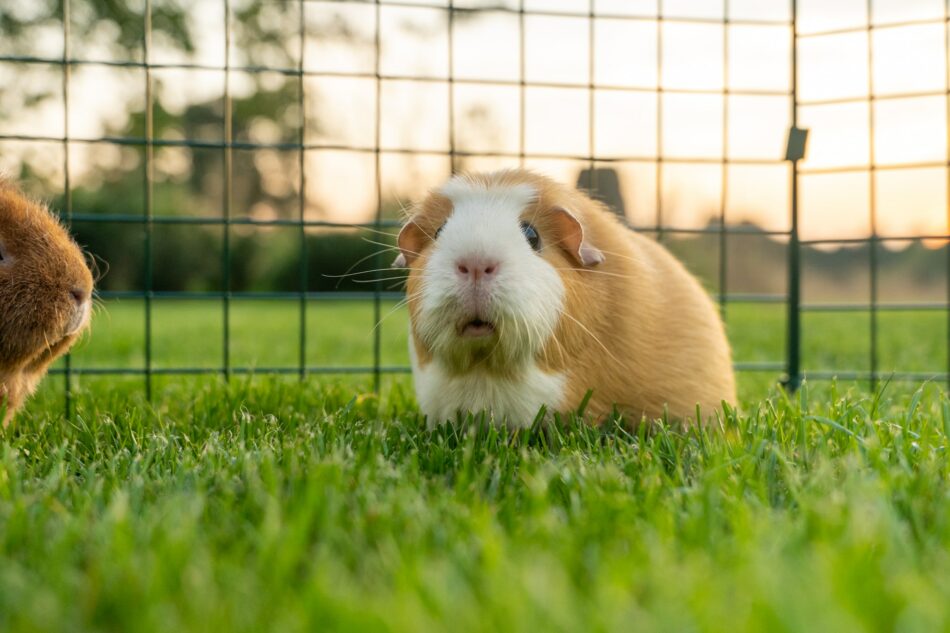

This entry was posted in Guinea Pigs
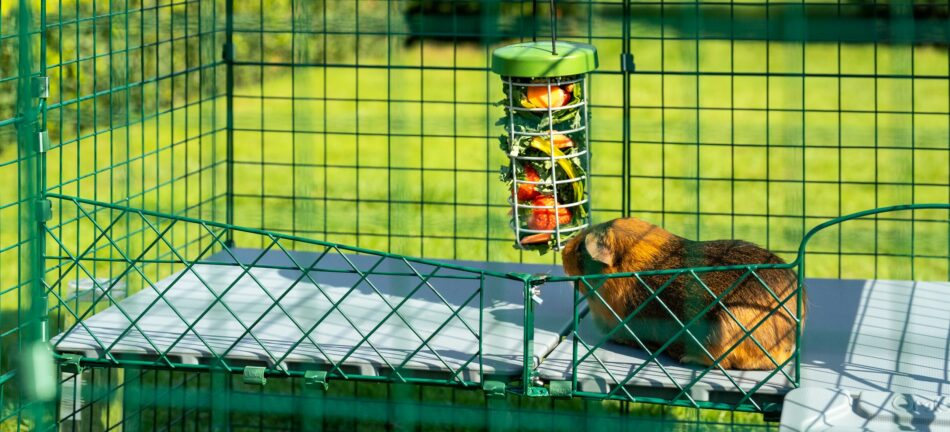
Guinea pig summer safety is an important undertaking for keeping cavies healthy and happy during the warmer months. Just like us, our guinea pigs can enjoy the season as long as they’re able to stay cool, hydrated, and comfortable. Omlet makes it possible for your guinea pigs to be able to weather the warmth and enjoy summer to the fullest.
Do guinea pigs enjoy summer?
Like many pets, guinea pigs are adaptable and can enjoy the warmer weather so long as:
- Your cavies are used to being housed outdoors for several hours a day
- They have plenty of water and shade
- You’re able to check in on them every couple of hours
Guinea pigs that are housed in a climate-controlled setting may experience shock from the sudden change in temperature if they’re taken out during the heat of the day. If you plan to take your indoor-raised cavy outside, make sure to introduce them to the higher temperatures gradually, starting during the coolest part of the day.
Cavies can live outdoors year-round if they’re housed in a well-ventilated and insulated guinea pig hutch. The Eglu Go Guinea Pig Hutch is designed to keep cavies comfortable in all weather conditions. The unique twin-wall insulation helps regulate the internal temperature while deflecting external heat.
Signs your guinea pigs are too hot
Recognizing the signs of heat stress in your guinea pigs is crucial for preventing them from experiencing heat stroke. Keep a close eye on both your guinea pigs and the thermometer to make sure they aren’t getting too hot outside.
Monitor for heat stroke in guinea pigs
It should be noted that even guinea pigs housed outdoors should be monitored closely when the weather warms up. Sudden temperature spikes or prolonged temperatures above 26°C can cause heat stress in guinea pigs, which can lead to heat stroke. Once cavies start to experience heat stroke, it’s very hard to reverse its effects. Not all guinea pigs will experience heat stress at these temperatures, but it’s important to keep a close eye on them regardless.
Heat stress vs. heat stroke in guinea pigs
Heat stress, or heat exhaustion, is the beginning stage of heat stroke. Heat stress occurs when your guinea pig’s internal temperature rises above their normal temperature of 39°C. Cavies experiencing heat stress may appear lethargic with heavier breathing than usual. Symptoms may appear suddenly, or come on gradually, but a guinea pig experiencing heat exhaustion can quickly progress to heat stroke. Any guinea pigs observed to be overheating should be brought into a cooler area until they act normally again.
Symptoms of heat stroke in guinea pigs
Once a guinea pig has progressed from heat stress to heat stroke, their symptoms can become serious quickly. Symptoms of heat stroke in guinea pigs include:
- Laying down – especially stretched out on their sides
- Heavy breathing or open-mouthed panting
- Dehydration
- Lethargy
- Seizures
If you see your cavy displaying any of these symptoms, bring them inside promptly. Refrain from cooling your guinea pig down too quickly – as this can cause their bodies to go into shock. Place them in front of a fan, and offer water if they are able to drink. Use room temperature water to cool them, never ice-cold. Place rags soaked in water on your guinea pigs to help cool them gradually, swapping them out every few minutes.
Call your veterinarian right away if your guinea pig does not perk up within a few minutes of being inside. Some effects of heat stroke are irreversible, even by a veterinarian, so time is of the essence. To err on the side of caution, even if your cavy perks up and acts normally after a while inside, you can still contact your veterinarian to discuss the next steps and if the event is expected to cause any lasting damage.
Which guinea pigs can get too hot?
Guinea pigs come in a variety of coat lengths and textures. Long-haired or thick-coated guinea pigs struggle the most in warm weather. These breeds include:
Because of their excess hair, they have a harder time feeling the cooling effects of a breeze or mist. They also require extra grooming to keep their coats in “working” condition. A guinea pig’s coat acts as natural insulation, keeping heat and cold away from their skin. If a guinea pig’s hair becomes matted down to their skin, they lose the insulating effects.
Another breed to take extra care with are Skinny Pigs, as they lack hair altogether – which means they have no built-in insulation to combat the heat. Though it may seem like they would be good candidates for warm weather, they are actually more sensitive to temperatures than their fully-furred counterparts.
3 tips for keeping guinea pigs cool in summer
Along with a ventilated and well-insulated hutch, there are other ways to help keep your guinea pigs cool during the summer months. Set up your cavies for a successful summer with these tips and tricks.
1. Create some shade
Your guinea pigs’ outdoor run is a great place to create shady places to relax during warmer weather. Zippi Guinea Pig Platforms not only give your cavies more room in their run, but also provide a shady spot to retreat to when the sun is out. Zippi Guinea Pig Shelters can be placed throughout the run to offer a hiding spot from UV rays as well. And, with guinea pig run weather covers you can create large shaded areas for your cavies to cool off in.
Add optional wheels and handles to your guinea pigs’ Eglu Go hutch to easily move them to a shadier spot in the yard. With the freedom to move with ease, you can relocate your piggies as often as the sun moves.
2. Offer frozen treats
Who doesn’t enjoy a good frozen treat on a hot summer day? Toss some guinea pig-friendly foods in the freezer to offer up during warmer weather. Fill a Caddi Guinea Pig Treat Holder with the chilled treats to reduce waste and help them last longer. The Caddi treat holder hangs easily from any Omlet run or other setup and can be adjusted to help piggies of all stature reach their frozen treats.
You can also freeze water bottles to place in the run or hutch with your cavies. Place the frozen bottles on their sides in a place where they won’t roll to prevent injuries. Offer 1-2 bottles per guinea pig, and watch them cosy up to these cooling containers.
3. Spend some time indoors
For particularly scorching temperatures, it may be best to bring your guinea pigs indoors during the heat of the day. You can create a safe space for them inside with a Zippi Guinea Pig Playpen so that they can enjoy the climate-controlled environment without getting into mischief. Guinea pigs’ ideal ambient temperatures are between 18-23°C. If you plan to put your guinea pig back outside, make sure not to keep them indoors for more than a few hours. The best time to bring them inside is during the hottest part of the day – usually around 3:00-4:00 pm until sunset. Once the sun goes down and the outdoor temperatures begin to fall, it will be safe to put your guinea pigs back in their home.
Omlet and your cavies
Keeping your cavies cool during the summer doesn’t have to be a chore. When you start out with the right setup, supplementing their well-being is much less work – leaving more time for summer fun with your guinea pigs. House your cavies in an Eglu Go Guinea Pig Hutch for year-round comfort, and add Zippi Guinea Pig Platforms for fun and shelter from the sun. Top their setup off with a Caddi Guinea Pig Treat Holder, and your guinea pigs will be ready to enjoy summers for years to come.


This entry was posted in Guinea Pigs

Trying to decide between male and female guinea pigs? It’s well known that guinea pigs do best in bonded pairs or small “herds”, but when it comes to selecting male or female cavies, things can get a little vague. Are there noticeable differences between the two? Can opposite genders be kept together? What are male and female guinea pigs called?
Male guinea pigs are called “boars” and female guinea pigs are called “sows”, just like their non-related namesakes. Boars and sows have slight differences in both appearance and personality. We’ll help you narrow down which to choose.
Physical differences
Guinea pigs somewhat resemble adorable potatoes. These plump, short-legged, bundles of energy have been known to provoke the humorous question: which end is the tail? Physical differences in their potato-esque bodies are subtle, but in general males will be larger than females.
Weight
Boars tend to weigh slightly more than sows – around half a pound heavier. Like other male animals, male guinea pigs may appear bulkier than females, even if they don’t weigh much more.
Length
Male guinea pigs can be slightly longer than females, however, this isn’t always the case. While a boar may appear larger than a sow, it’s usually by weight rather than length.
Behavioural differences
The most notable differences between male and female guinea pigs are seen through their behaviour and personalities. Here we’ll outline some of the most common behavioural differences between boars and sows.
Aggression
Males have testosterone, and boars that aren’t neutered have an abundance of it! This can sometimes lead to territorial aggression in male guinea pigs – both among cagemates and caretakers. A large guinea pig hutch and run is necessary when housing male guinea pigs together. Small enclosures can create strife between boars, so it’s best to give them as much room as possible. Secondary runs, such as the Zippi Guinea Pig Runs can be connected to their main enclosure through the Zippi Guinea Pig Tunnel System to give them plenty of space to spread out.
Female guinea pigs aren’t usually aggressive with each other, but each individual cavy is different. In general, sows live together amicably, but can occasionally exhibit territorial aggression if kept in enclosures that are too small for them. Like with males, giving female guinea pigs as much space as possible is always the safest option.
Trainability
Each individual guinea pig will have their own personality, but boars tend to be more outgoing and curious with their owners. Sows are generally more shy and content to hide out. Training guinea pigs is possible no matter what personality type your cavy has, but as a general rule, may be easier with males.
Appetite
Since boars are larger than sows, they’ll need to eat more. And, for reasons unclear to humans, male guinea pigs tend to get very messy with their meals. It’s not uncommon for boars to toss their pellets or spread their hay around their hutch and run. A Caddi Treat Holder is a great solution to serve fresh fruits and vegetables or hay to boars to reduce waste. Sows may not need to eat as often, but should still have quality pellets and hay available to them at all times.
Vocalizations
Guinea pigs have their own language that they try to impart to their humans. Any guinea pig can get vocal (especially around mealtimes), but males may be particularly loud. This is partly because of their more outgoing personalities, and partly because they are more robust by nature. Still, sows will make plenty of noises that only guinea pigs can muster!
Lifespan
On average, male guinea pigs have a lifespan of 1-2 years longer than females. However, the lifespan of all cavies is largely dependent on their diet, care, and environment. Guinea pigs often suffer from being overweight, which puts extra pressure on their small frame, so keeping them active is necessary for a long lifespan. Guinea pig accessories are an excellent way to add physical and mental enrichment to any guinea pig’s life.
Maintenance and care
Boars have a musky odour that is off-putting to many owners. This smell is the result of glands that are used in marking territory and attracting females – though not attractive to human noses! They’re also notorious for spilling food and water, and are perfectly content to stew in the mess they’ve created.
Many owners want to know how to reduce guinea pig smells, but an easy-to-clean guinea pig hutch is the best method for warding off unwanted odours. Wiping down the inside of the hutch and refreshing the bedding daily makes a huge difference in preventing unwanted smells from your guinea pigs.
Regular hutch cleanings are usually all that’s needed to keep your guinea pig looking and smelling fresh, but some cavies with longer coats may need additional care. It’s generally not advised to bathe a guinea pig regardless of gender or breed, but grooming your guinea pig can be a great bonding experience.
Both male and female guinea pigs can thrive outdoors all year round. A quality guinea pig hutch fosters their natural instincts, keeps them cool in summer and warm in winter, and gives them plenty of room to enjoy the outdoors. It’s common to see owners house their cavies inside, but guinea pigs thrive in an outdoor environment so long as their needs are met.
Guinea pig breeds and behaviour
Sometimes behaviour is more heavily influenced by the breeds of guinea pigs than their genders. No matter which breed or gender you choose, it’s important to meet the guinea pig you are thinking about adding to your family to get a feel for their unique personality. Many guinea pig owners find themselves surprised by bringing home a cavy that is neither the gender nor breed they originally planned on. The best practice is to bring home the piggie whose disposition complements your own.
Cohabitating
Because of their territorial nature, it’s best to have just a bonded pair of males, unless you have plenty of space to expand their territory. Small herds of females are another good option if you’re considering adopting more than a bonded pair. Sometimes, you may find a neutered male guinea pig in need of a home, or may consider having your boar neutered. Neutered males living together display less aggression, and can be housed with females without the risk of accidental litters. If you’re interested in having a male guinea pig neutered, be sure to find a veterinarian that is familiar with altering cavies – it’s not as common of a procedure for guinea pigs as it is for dogs and cats.
Omlet and your guineas
Omlet makes products that help you keep your guinea pigs healthy and happy. Our line of guinea pig products makes caring for your cavies fun and enjoyable. Whether you choose boars or sows, choose Omlet products to help them live their best lives.
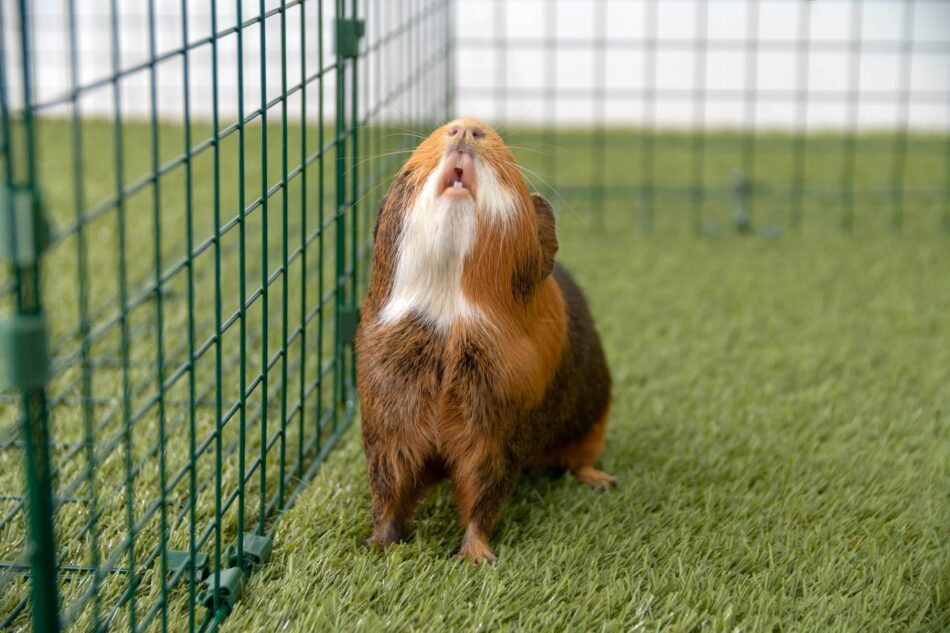
This entry was posted in Guinea Pigs
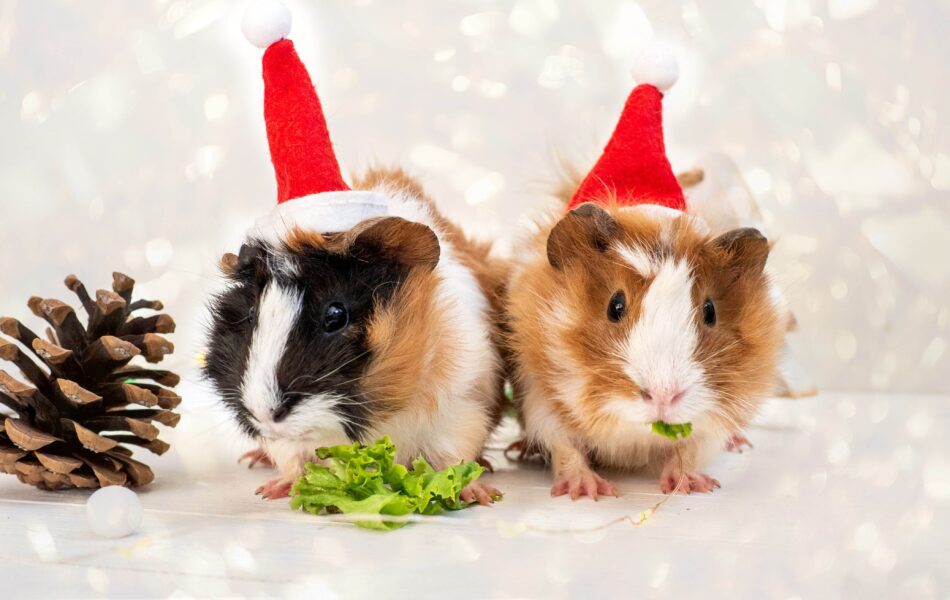
Christmas is the most magical part of the season. It’s the perfect time to snuggle up with your small furry friend and enjoy this special time of year.
And let’s not forget the food. Christmas is one of the biggest holidays for a “foodie,” and if you share a home with a rabbit or guinea pig, you know they’re foodies too. Thankfully, there are several festive treats that you can share with your food-loving friends – just hold the seasoning and spices.
What are your Christmas meal staples? If you’re like most, your Christmas spread probably includes turkey, stuffing, various vegetables, and sides, punctuated with decadent desserts. And with all that meal prep, there are lots of scraps and trimmings that you can give your rabbit or guinea pig as a special holiday treat.
Treats for your bunnies
Rabbits and carrots go together like turkey and gravy. But what other trimmings can you save for your bunny when you’re prepping for your Christmas meal?
Rabbit-safe Christmas meal ingredients that you can share with your bunny include: carrots and their tops (though in moderation, as carrots are high in sugar – which is why rabbits love them), celery, cranberries (fresh or unsweetened and dried), fresh green beans, and leafy greens such as lettuce and cabbage. And if your Christmas dinner doesn’t stick to the traditional menu, a list of rabbit-safe foods can be referenced to see what you can feed your bunny from the kitchen.
The easiest way to keep your rabbit’s treats separate from what gets tossed and what gets seasoned is to keep a bunny bowl on the counter. Any trimmings that are meant for your rabbit can be scooped into a bowl and offered once you’re done with your meal prepping – just make sure all of your helping hands in the kitchen know what this is for.
If you’re really feeling festive, you can also find many recipes online for rabbit-friendly baked goods like carrot cake or banana treats to make their holiday extra special.
Guinea pig goodies
Guinea pigs follow a diet that resembles a rabbit’s, except that they need more vitamin C as they cannot manufacture their own. The same foods that you reserve for your rabbit can be safely offered to your guinea pig, but some additional considerations for cavies are: small amounts of orange or orange peel, bell peppers (yellow, red, or orange are best), broccoli, apple slices, and berries.
Part of the cuteness of cavies is their build, but with their little legs and larger bodies, it’s important not to overfeed them. Ideas for guinea pig baked goods can also be found online, but any holiday goodies should be served as a one-time treat.
Keep a cavy cup handy in the kitchen during holiday baking and meal prep. If possible, refrigerate excess scraps to offer at a later date if your cup “runneth over!”
Holiday hazards
While there are many delicious and nutritious foods to share with your rabbit or guinea pig, there are also holiday staples that should not be shared. Avoid feeding:
- Nuts and seeds
- Potatoes (especially if raw)
- Sugary or baked goods
- Bread
- Meat
If your rabbit or guinea pig happens to sneak a taste of something they shouldn’t, identify what it was and how much they ingested and call your vet. Christmas is the most common time of the year for pets (large and small) to get into something they shouldn’t, so take precautions to ensure your bunny or cavy aren’t able to sneak a bite. Make sure your rabbit or guinea pig is safe in their hutch or run, or set up a rabbit or guinea pig playpen to keep your furry family members out of the kitchen and away from falling foods and cooking utensils.

Special occasion treats and year-round feeding
Rabbits and guinea pigs both need a quality pellet feed (ideally timothy hay-based), and unlimited access to timothy hay or orchard grass and fresh water, with guinea pigs needing additional vitamin C. Around 90% of both your rabbit and guinea pig’s diet should consist of these staples, with treats being given no more than a few times a week.
The best treats are those that incorporate into a well-balanced diet for bunnies and cavies, such as vegetables or fruits that offer nutritional value. Anything indulgent should be offered on special occasions like holidays or your pet’s birthday – otherwise, it might upset their digestive systems or influence their food preferences.
Feeding treats in a Caddi rabbit treat holder or a Caddi guinea pig treat holder is a great way to keep their favourite treats together and up off the ground. It’s also a nice “plating” option when serving up special holiday fare.
A home for the holidays
The holiday season should be a time of comfort and joy for both you and your furry family members. This time of the year also brings colder temperatures and freezing precipitation, so be sure your rabbit or guinea pig is housed in an insulated rabbit hutch or guinea pig hutch for optimum cosiness. And bring on the joy with Zippi tunnels and playpens for endless fun so guinea pigs and rabbits can warm up their bodies and appetites.
With a warm home, full bellies, and loving humans, your small furry family members are sure to have the best holiday season.

This entry was posted in Christmas
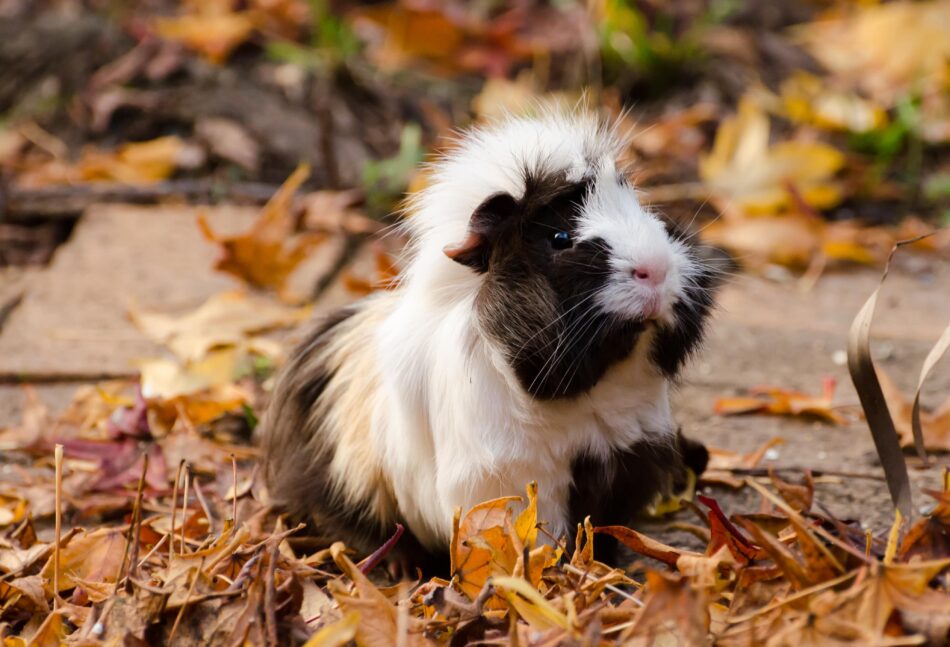
Did you know that there are many different breeds of guinea pigs? There are actually 13 breeds recognized by the American Cavy Breeders of America (ACBA), and several other varieties that have emerged through selective breeding. Some are larger than others, and their personalities differ slightly between breeds – but overall the biggest difference between types of guinea pigs is their coats. A guinea pig’s fur can be short, long, straight, curly, or in the case of “skinny pigs,” non-existent!
Some guinea pigs have such long hair that they appear as though they’re wearing skirts, and some have tight, curly hair that gives them a fluffy appearance. Among the 13 recognized breeds from the ACBA, 5 are long-haired, and 5 are textured! So what people commonly think of when they visualize guinea pigs (short hair with various markings), is actually a minority of guinea pig breeds.
“Skinny pigs” (hairless guinea pigs), dalmatian guinea pigs, and fox guinea pigs are all examples of “experimental” breeds that have emerged recently. Experimental breeds are those that are selectively bred for a desired trait, and once that trait can be replicated for several generations, can one day become a recognized breed at a national level.
Even though some breeds may require more grooming than others, on the whole guinea pigs remain one of the best starter pets for children, and some of the easiest small animals to take care of. Discover the many coats of cavies, and how to choose the right guinea pig for you!
Hair or fur?
Does a guinea pig have hair or fur? Or is there a difference?
Hair is an individual component of fur, which is the collective term. Technically all mammals have fur, because they are covered in hairs – including humans! Hair can also be defined as ever-growing length that is independent of fur, which grows to a definitive length and does not require trimming.
Like most mammals, guinea pigs have fur that covers their bodies. In fact, they are precocial, which means they are born with fur, teeth, and the ability to walk! But longhaired breed guinea pigs have coats much like longhaired dogs and cats that grow continuously throughout their lives.
The fur on guinea pigs serves the same purpose that it does in all mammals – insulation, protection from elements, and of course, visual appeal! But one type of guinea pig, known as the “skinny pig,” has actually been bred to be completely hairless, save for the occasional patch of fur around their ears or muzzles. Since they don’t have fur, skinny pigs are not good candidates for living outdoors, as they cannot regulate their temperatures without fur for insulation. But, even though they might not come in the variety of colours and textures as their clothed-cousins, they still have the cuteness factor!
Do guinea pigs shed?
Guinea pigs shed seasonally just as other household pets do. A guinea pig will release the dense undercoat they grew for the winter come spring, and will shed throughout the summer as the weather warms. By brushing your guinea pigs regularly, you can assist them in ridding their coats of excess hair.
Shedding shouldn’t be a concern unless your cavy is shedding excessively in the cooler months, or if they are losing hair to the point of having bald patches. If you notice your guinea pig scratching or pulling at their coat, or notice any red or irritated skin, contact your veterinarian.
Can guinea pigs change colours?
While patterns and base colours remain the same, the shade of your guinea pig is likely to change with the seasons – and some changes might actually be permanent!
When a guinea pig is about 3 months old, they will shed their baby fur and grow an adult coat. Sometimes they can change colours entirely during this progression! Seasonal shedding can also alter the appearance of your guinea pig due to the decreased presence of their dense undercoat. As your guinea pig ages, each shedding and regrowing season may bring a new hue to their coat, which can be a permanent change.
The only colour change you should be wary of is yellow, as this indicates urine staining on your guinea pig. Make sure you change their bedding frequently so that they don’t stand or lay in their urine to avoid staining their coat and inviting bacterial infections to start.

Short-haired guinea pig breeds
There are three officially recognized breeds of short-coated guinea pigs: American, American Satin, and White Crested. The American breed is the most common, and is known for its gentle and docile temperament and low-maintenance coat. They are also known to be very friendly with other guinea pigs, which makes them a great choice if you already have a guinea pig or two.
Other breeds of piggies that are considered short to medium-haired have textured coats. These breeds are: Abyssinian, Abyssinian Satin, Teddy, and Teddy Satin. Abyssinian guinea pigs have whorls (officially known as “rosettes”) that look like cowlicks all over their bodies, giving them a quirky appearance! Teddy breeds have very dense and velvety coats with lots of volume – the density of their coat makes it stand up and away from their bodies, in a very “plushy” look. Satin breeds have a sleek and shiny coat in addition to their breed-specific patterns or traits.
Long-haired guinea pig breeds
Guinea pigs with long hair require more maintenance than those with shorter coats, but if you keep up with their grooming, they are remarkable to behold! Piggies with long, luscious locks include: Coronet, Peruvian, Peruvian Satin, Silkie, Silkie Satin, and Texel.
All of these breeds (except Texels), have long, flowing locks that give them a “walking-mop” appearance. Both striking and adorable, some of these breeds can have coats up to 24 inches long! One of the smallest breeds of guinea pigs, the Texel makes up for its size difference in astonishing curls that hang in ringlets from their bodies. Their coats can be combed or brushed into waves, or be detangled gently to keep their bouncy, corkscrew curls.
All long-haired guinea pigs share the same friendly and easy going demeanour as their short-haired cousins, but some are known to be a little mischievous if they become bored! Like all cavies, long haired guinea pigs need enriching activities that challenge both their minds and bodies. Guinea pig treat holders are a great way to encourage foraging and to stretch out little legs and backs while keeping hair out of their snacks!
How do I groom my guinea pig?
Both long and short haired guinea pigs need some routine grooming. They don’t need to be bathed often – in fact, you want to avoid giving your guinea pig a bath unless they have urine-stains or got exceptionally filthy. Frequent bathing can dry out their skin and open themselves to bacterial or fungal infections more readily. This is especially true for hairless guinea pigs, which should never be bathed.
When performing routine grooming for your guinea pig, you’ll want to focus on their: teeth, nails, coat, and face.
Don’t worry – you don’t have to go out and find a tiny toothbrush for your cavy! You’ll just want to watch your guinea pig munch on a treat, or hold them gently and pull down their bottom lip to make sure they aren’t getting “long in the tooth.” Like all rodents, their teeth grow continuously, and they chew and nibble on things daily to wear them down. A healthy guinea pig mouth should have white teeth with minimal overlap in the front. Minor tooth staining is normal for cavies eating fruits and vegetables, and isn’t a cause for concern unless the entire tooth is affected.
Regular nail trimming should be part of your guinea pig’s grooming routine. Cavies that live outside, or that have ample room in a guinea pig run will need less frequent nail trimming, as they will wear them down while they’re running and playing. When you trim your guinea pig’s nails, make sure that you can see the blood supply (the “quick”) so that you don’t accidentally nick them. And don’t try to trim the nails on a restless guinea pig – wait until they are relaxed and comfortable being in a good position to handle their nails. This may take some practice sessions without actually trimming their nails (treats go a long way!).
Coats of short-haired guinea pigs may need to be brushed in the spring or summer when they shed their undercoats, but it usually isn’t necessary to brush them on a regular basis. Long-haired guinea pigs should be brushed several times a week, depending on their housing conditions and length of their coat. Consider using recycled paper or pine pellets for bedding in long-haired guinea pig homes, as shavings can become tangled in long hair.
To finish up your grooming routine, check your guinea pig’s face for any discharge from the eyes or nose. Clear drainage is normal, but if you notice white or yellow discharge, contact your veterinarian.
Grooming your guinea pig will help strengthen your bond and ensure that your cavy is in good health. Think of each grooming session as another chance to build trust with your guinea pig, and for you to do a brief examination of their health.
Making care even easier and more fun
Guinea pigs are some of the easiest pets to care for – and some of the most enjoyable! You’ll be rewarded with “wheeks” and “chuts” and “popcorning” as part of a language unique to guinea pigs, and probably a cuddle or two!
As with any pet, starting with a good foundation is key. A quality guinea pig hutch is essential in providing the best care for your cavy. Guinea pig shelters and tunnels make for functional accessories that make your guinea pig feel more comfortable in their environment, while providing them with mental and physical exercise.
Have you decided on which breed of guinea pig to add to your family? Let us know below!
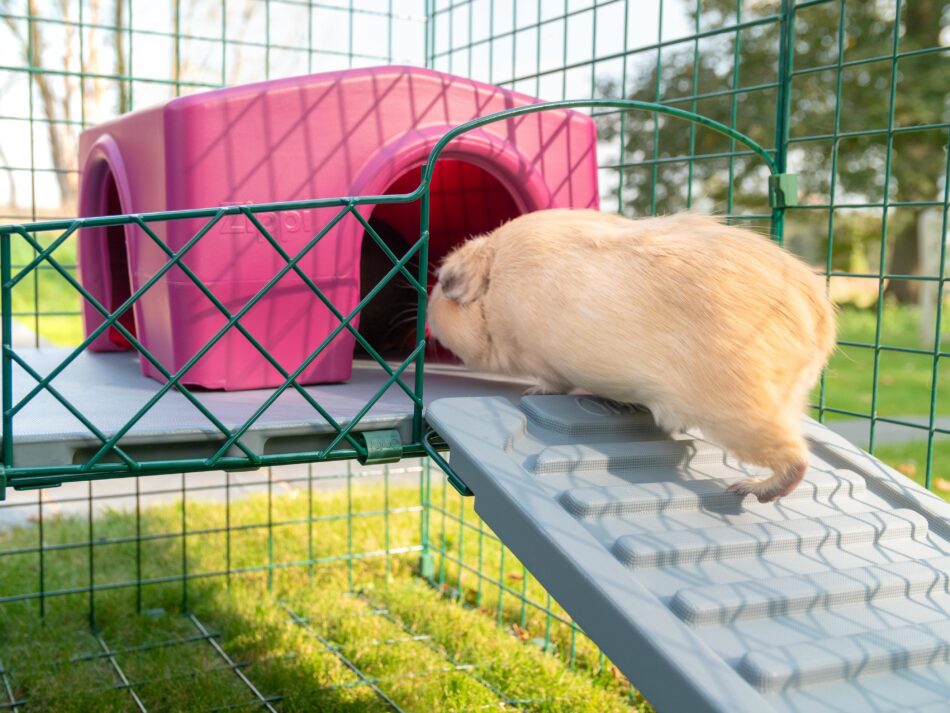
This entry was posted in Guinea Pigs

Guinea pigs make for incredibly entertaining and enjoyable pets. They’re highly social, recognize (and “talk” to!) their humans, and are capable of learning tricks and basic commands. So why would anyone want to part with one?
Like any pet, guinea pigs are an addition to a family and require care and attention. Adding any pet to a family is a big commitment! Cavies (a shorthand name of the scientific name for guinea pigs) make excellent pets for children, as they are known for their gentle dispositions and adorable personalities. But unlike other small pets, guinea pigs have a long lifespan for rodents: up to 8 years! Compared to a shorter life span of 2-3 years for hamsters or gerbils, families often don’t realize just how long a guinea pig will be part of the family. Guinea pigs also require more space than pocket-pets, eat more, and prefer to be kept in pairs or small groups. And, if not provided with enough enrichment and opportunities to exercise, they become bored and will vocalise their displeasure! For these reasons, hundreds of guinea pigs are surrendered to shelters and rescue groups every year, hoping to find their forever homes.
Reasons to rescue
Adopting a guinea pig is one of the most noble and commendable ways to become a proud owner of a cavy (or two)! Shelters are not usually equipped with the necessities to keep a cavy comfortable, and are noisy/scary places for a small pet!
You can help by adopting a guinea pig directly from the shelter, or from a rescue group! Your adoption/rehoming fee goes directly back into the organisation’s funds for feeding, caring for, and rescuing future pets.
Are you on the fence about owning guinea pigs? You may be interested in fostering one or two! Fostering guinea pigs takes the pressure of being a permanent home off of you, while still providing a safe place for them while you find their perfect home. Check with local guinea pig rescue organisations to see if you can join their list of foster homes – many of them will help you financially care for the guinea pigs you foster, or offer supplies such as bedding and food. It’s also a great opportunity to see if owning a guinea pig is right for you!
Adopting vs. shopping
You’re probably familiar with the campaign of “adopt, don’t shop” that shelters and rescue groups use for finding homes for dogs in particular. While there’s nothing inherently wrong with “shopping” (purchasing from a breeder or store) to obtain a guinea pig, there are plenty of cavies in need of forever homes if you know where to look.
Animal shelters and adoption centres near you can be found online. Be sure to ask them if they have any guinea pigs available – just because they aren’t listed online doesn’t mean they don’t come across them!
Rescue groups or individuals are also great resources when looking to adopt a guinea pig, and will usually offer continued education and assistance after you adopt through them. These groups or individuals can be found through an online search, Facebook groups or through your local shelter or veterinarian.
It’s important to check the credibility of a rescue group or individual before adopting from them. You can ask a group for their non-profit status and to check the efforts of an individual, ask them for references and/or ask them which veterinarian they take their cavies to. When you call the veterinarian’s office, they should be more than happy to verify that the individual brings guinea pigs in for care.
A coat for every occasion
Choosing the right guinea pig breed isn’t entirely necessary, but it is fun! Guinea pigs all have unique personalities, but are universally known to be sweet, good-natured pets. Breeds have primarily been developed for different coat types – and there are many different varieties! Choosing the right breed for your family really comes down to how you want your guinea pig’s coat to look, and how much time you’d like to spend grooming and brushing them. Coats range from long to short and straight to curly – with some guinea pigs having no hair at all!
If there’s a particular breed with a coat that appeals most to you, you may want to go through a breeder or a rescue group that really knows their cavies! Still, in checking with shelters and rescues routinely, you may stumble upon your perfect piggy – or one that steals your heart regardless of their hair! Be sure to ask the shelter or rescue to put your name on a list if you are searching for a specific type of guinea pig.
The main attributes to consider when adopting a guinea pig are:
Is it a young or senior guinea pig? Are you adopting more than one? If so, be sure to get same-sex pairs to avoid accidental litters of guinea pig pups! And is the guinea pig you’re considering outgoing or shy?
Finding a guinea pig that fits into your lifestyle and meshes with your family is the most important part of choosing your cavy. Even if the guinea pig you see at the shelter or rescue isn’t the one for you, you can spread the word on social media to help it find its forever home!
Prepare for “popcorning”
If you aren’t familiar with guinea pigs, one of the most adorable things they do when they’re happy is something called “popcorning.” When a guinea pig is at their happiest, they will quite literally jump for joy – twisting and grunting to form the action known as a guinea pig “popcorn.”
So how do you get your piggy to popcorn? You help them live their best life through shelter, play, diet, and basic care!
By choosing a high-quality enclosure like the Eglu Go Guinea Pig Hutch from the beginning, you’ll avoid having to replace it down the road. We invented this hutch with the spirit of enabling guinea pigs to enjoy nature safely and securely.
That’s right – you can house your guinea pig outside, all year long! It’s a common misconception that guinea pigs have to be housed indoors, but they’re actually quite capable of adapting to life outside! The added benefits of having an Eglu Go Guinea Pig Hutch include: weather and predator protection, anti-gnawing and chewing design, and being super easy to clean!
Regardless of whether you keep your cavy indoors or outdoors, they’ll need engaging activities to exercise their minds and bodies. Since guinea pigs love to tunnel (but not dig their own!), a system of Zippi Guinea Pig Tunnels is an excellent way to curb boredom and move those little legs! Combine the tunnels with Zippi Guinea Pig Runs and Playpens for safe, enclosed playtime – inside or outside!
Setting up an enriching, safe place for your guinea pig will help them adjust easier and faster, which allows you to spend less time cleaning and more time playing and bonding with them!
Caring for your cavy
Once you have all of the proper equipment, guinea pigs are relatively easy to care for. Their diet should consist mainly of ruffage such as Timothy hay, fed in unlimited amounts. They should also be fed a hay-based pellet that is high in fibre to keep their little bellies in working order.
Like humans, guinea pigs cannot manufacture their own vitamin C, so make sure that their pelleted food has added vitamin C. If not, commercially purchased supplements can be fed or added to their water. You can also offer vegetables high in vitamin C such as bell peppers, tomatoes and asparagus. Fruits are a source of vitamin C as well, but should be fed sparingly as it’s very easy for a guinea pig to become overweight! Small amounts of oranges or kiwi may be given once or twice a week for a treat that packs a dose of vitamin C.
The Caddi Guinea Pig Treat Holder is a fun way to offer up your cavy’s favourite foods. Stuff it with hay, leafy greens, or other guinea pig-safe delicacies for hours of fun. When you’re as cute as a guinea pig, it’s okay to play with your food!
In addition to their diet, you should make sure your guinea pig always has access to fresh, clean water. Avoid any bowls low enough for them to step in, tip over, or kick bedding into. Run-mounted crocks or drinkers are good options for offering water to your cavy. You can also use an elevated cat bowl to offer water inside of your guinea pig’s hutch, as long as it’s high enough to keep them from taking a dip, and low enough for their mouths to reach!
Exercise is important for a guinea pig so that they maintain a healthy weight. Extra ounces on a guinea pig can lead to metabolic or digestive issues, and put unnecessary strain on their little legs which can cause joint pain. Zippi Guinea Pig Platforms are a great way to encourage your guinea pig to put in some extra steps! Try serving their food on the platform to encourage them to climb up and down the ramp. You can also build obstacle courses out of cardboard boxes to encourage physical activity – just be sure there’s a reward at the end!
Basic grooming and health checks will ensure your guinea pig is feeling its best. If you find anything amiss during a routine once-over, be sure to notify your veterinarian. For a list of these basic activities, visit: 5 Guinea Pig Care Tips.
Build a bond that lasts a lifetime
To ensure you and your newly-rescued guinea pig get off on the right foot, remember to:
- Choose a high-quality hutch designed for guinea pigs
- Offer stimulating and enriching enclosures and playtime
- Feed an appropriate diet
- Find a veterinarian that treats guinea pigs in case of illness or emergencies
When all of a guinea pig’s basic needs are met, you’ll find that they make wonderful companions! They have many adorable attributes such as popcorning, scampering, playing, and chattering (see: How to Understand the Language of Guinea Pigs).
By nature, guinea pigs will bond with another of their kind, which is why it’s best to keep them in pairs. Having a pal that speaks your language is great, but cavies also desire and build relationships with their human-caretakers! Talk to your guinea pig often, offer food by hand (careful not to accidentally put your finger in harm’s way), and visit with your guinea pig frequently. Above all, be patient. Bonding with any animal doesn’t happen overnight, but before long your guinea pig will accept you as their friend. Once a bond has been established, it is not easily broken, so take your time. Your piggy will be greeting you with a series of “wheeks”, “chuts”, and “coos” in no time – especially if there’s food involved!
Confidence and support
Adopting a guinea pig is a big decision, but with adequate resources and preparation, it can be one of the most rewarding decisions you’ll make as a pet owner!
We’ve created our products to help your guinea pig adjust to life in their forever home. Because our hutches are meant to be a “forever” solution – no rotting, breaking down, or showing the wear and tear of wooden hutches – you can have the confidence that your adopted cavy is living safely and happily ever after in their new home.
We hope that you take the leap and open your home and heart to a guinea pig in need of rescuing. If you have any questions about how to adopt a guinea pig, or basic guinea pig care, let us know!

This entry was posted in Guinea Pigs










































